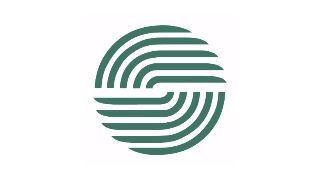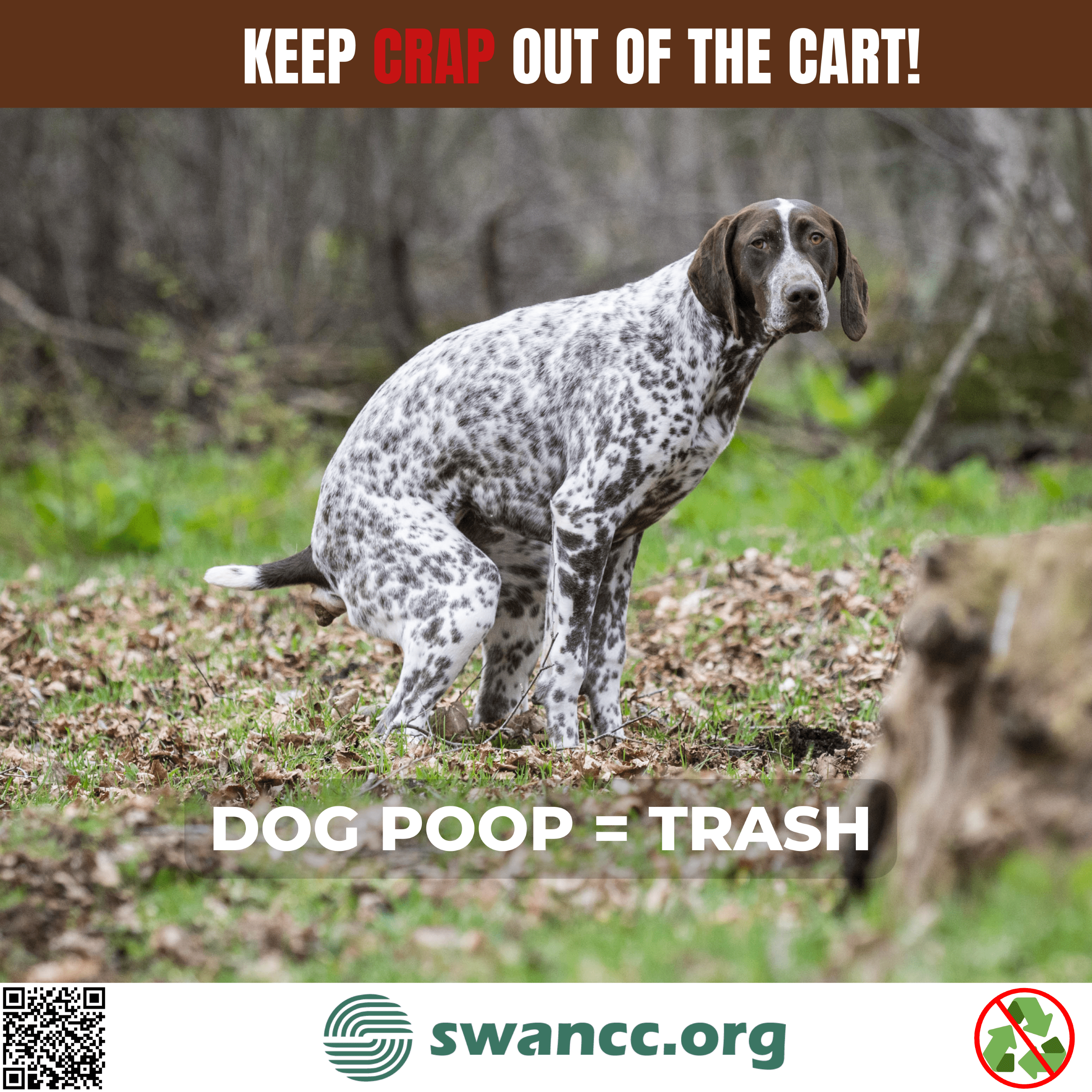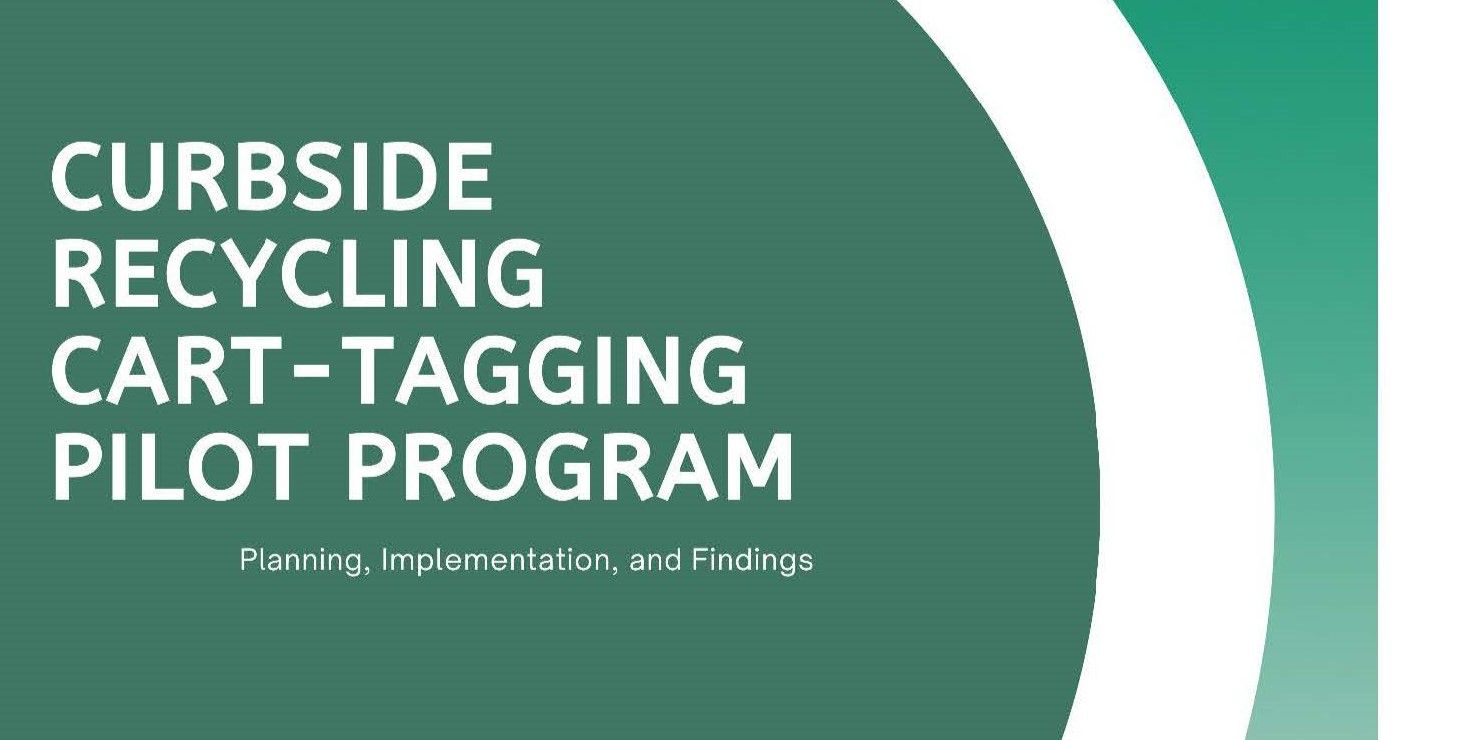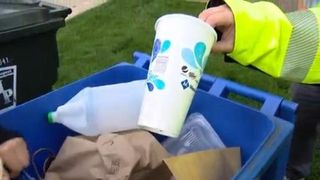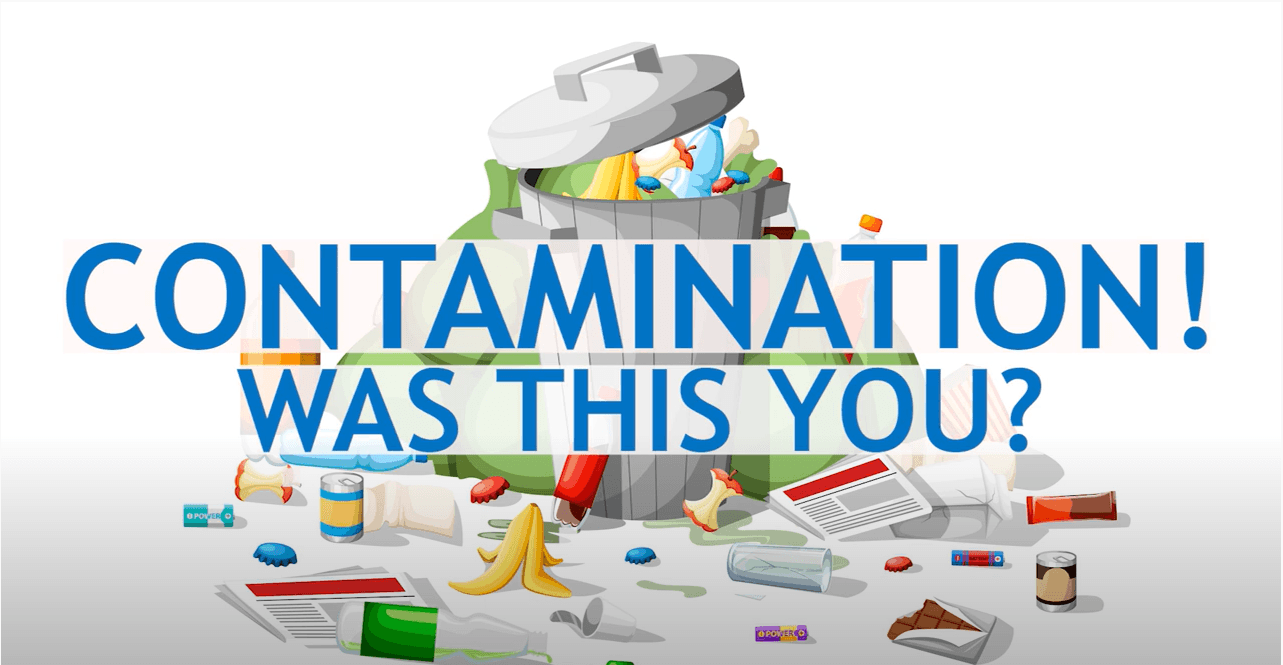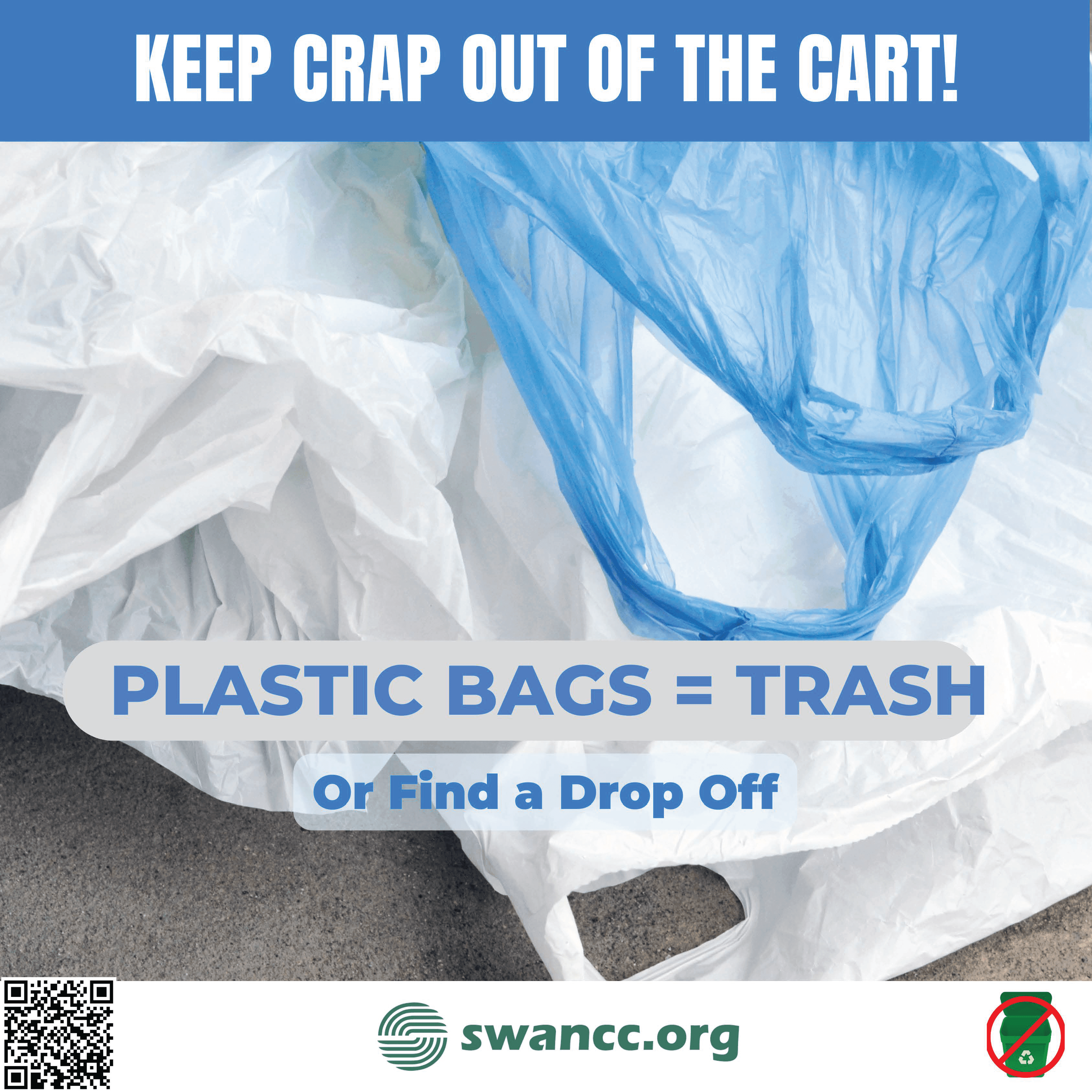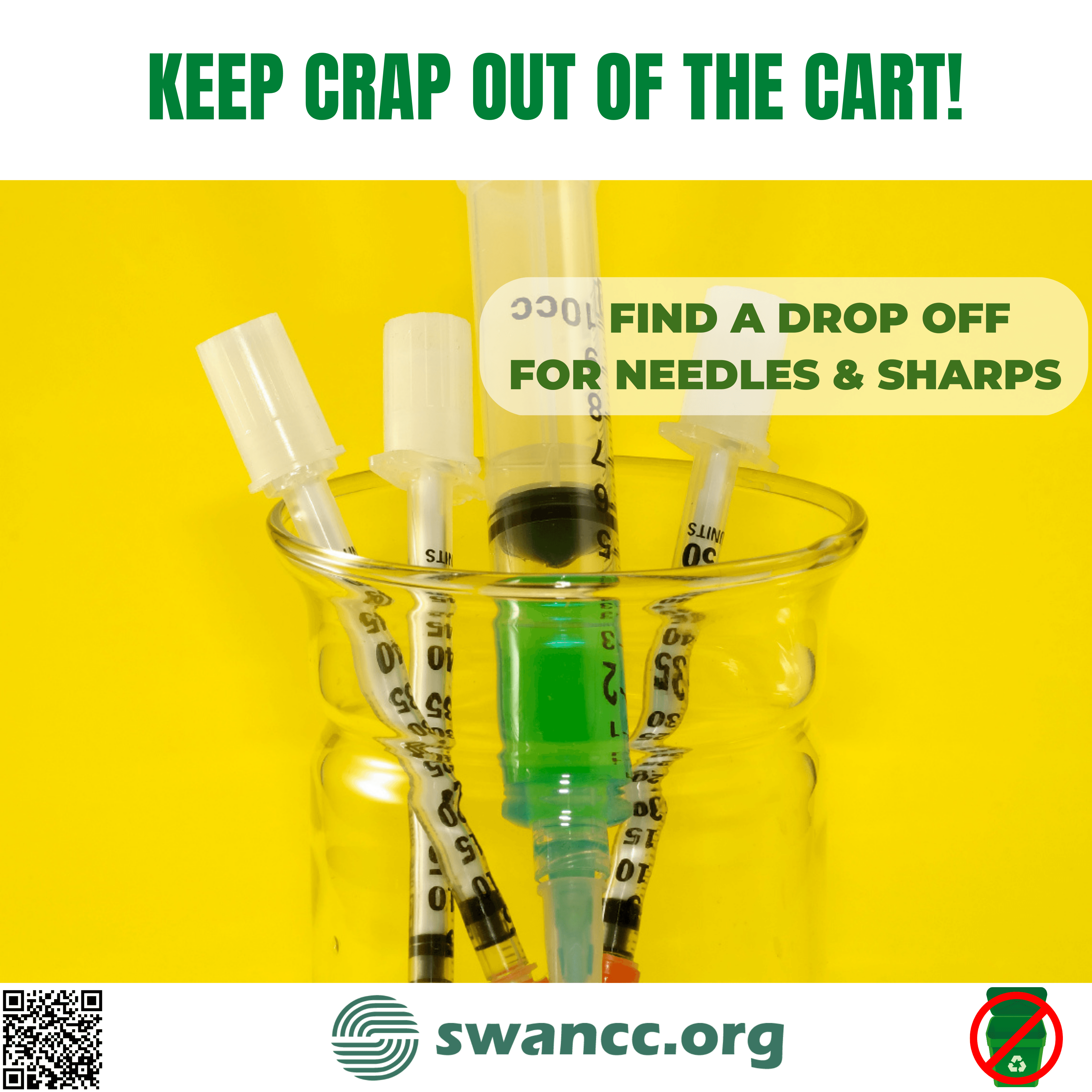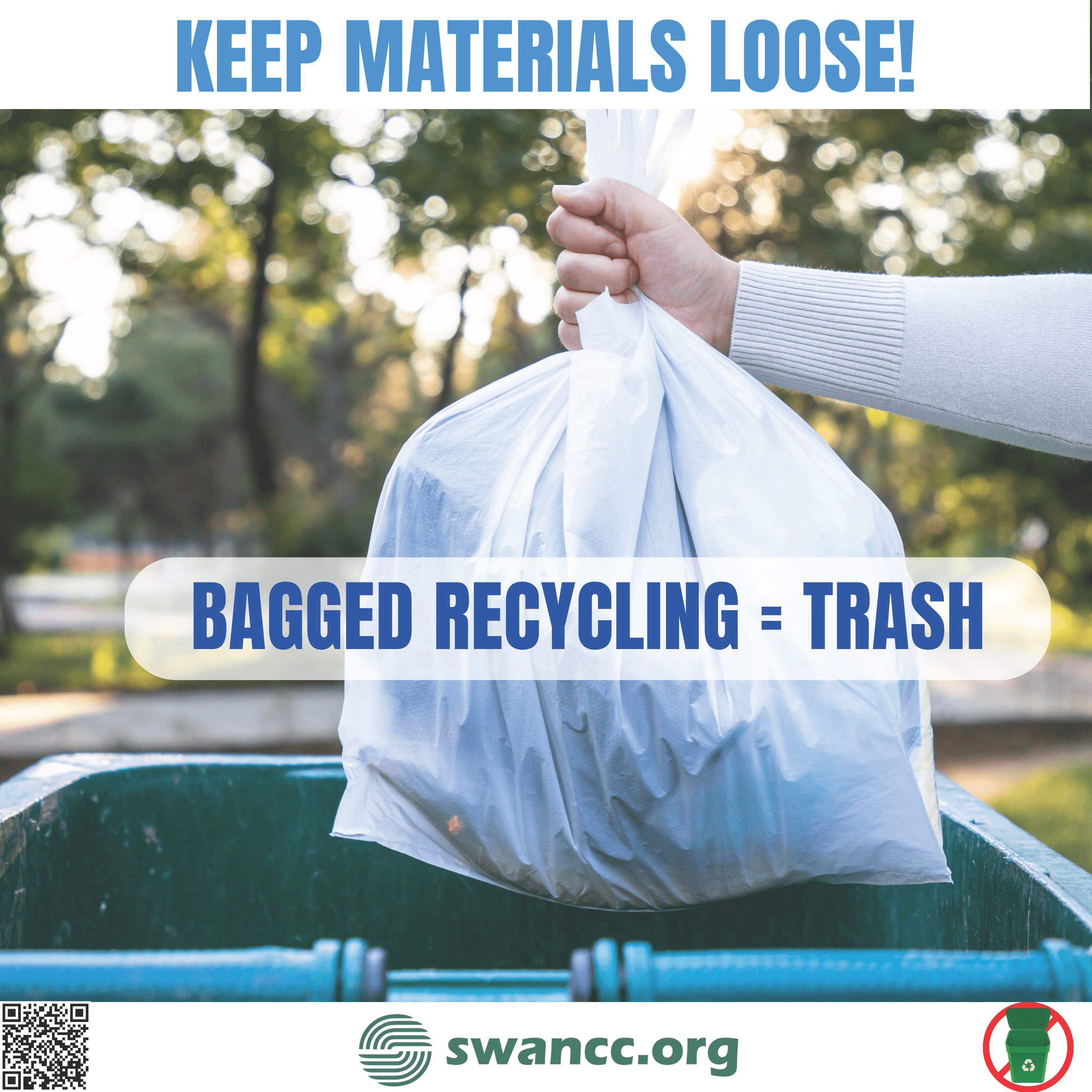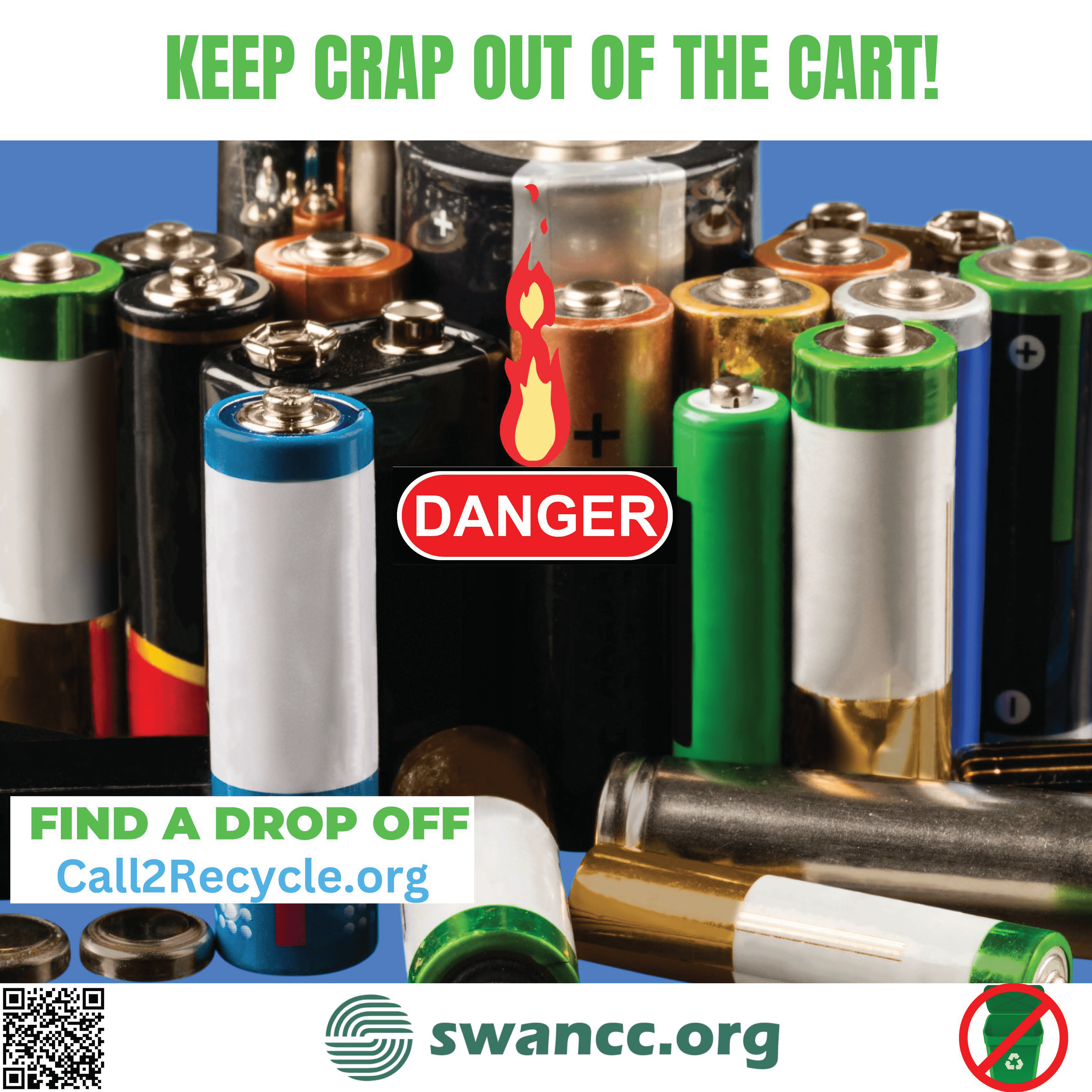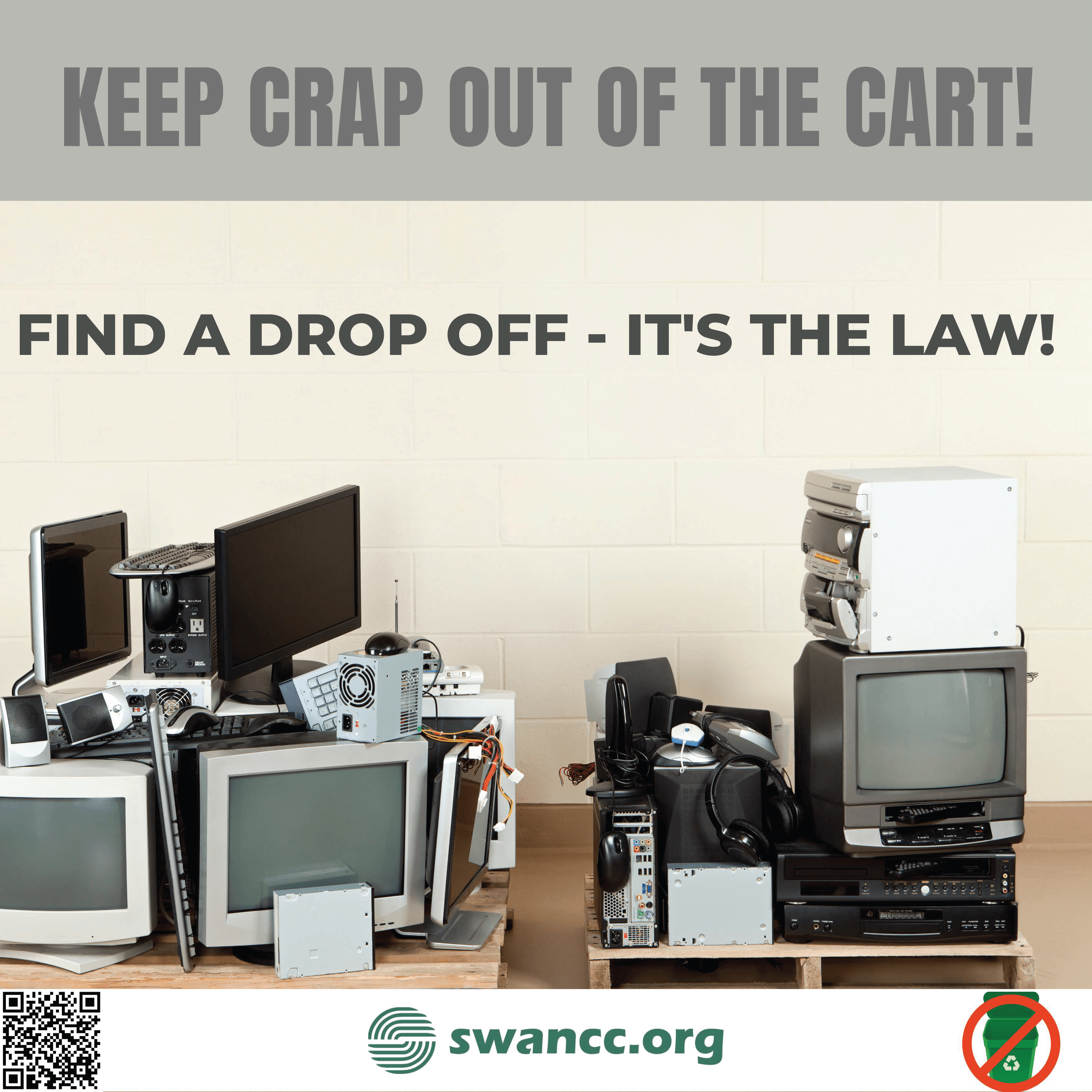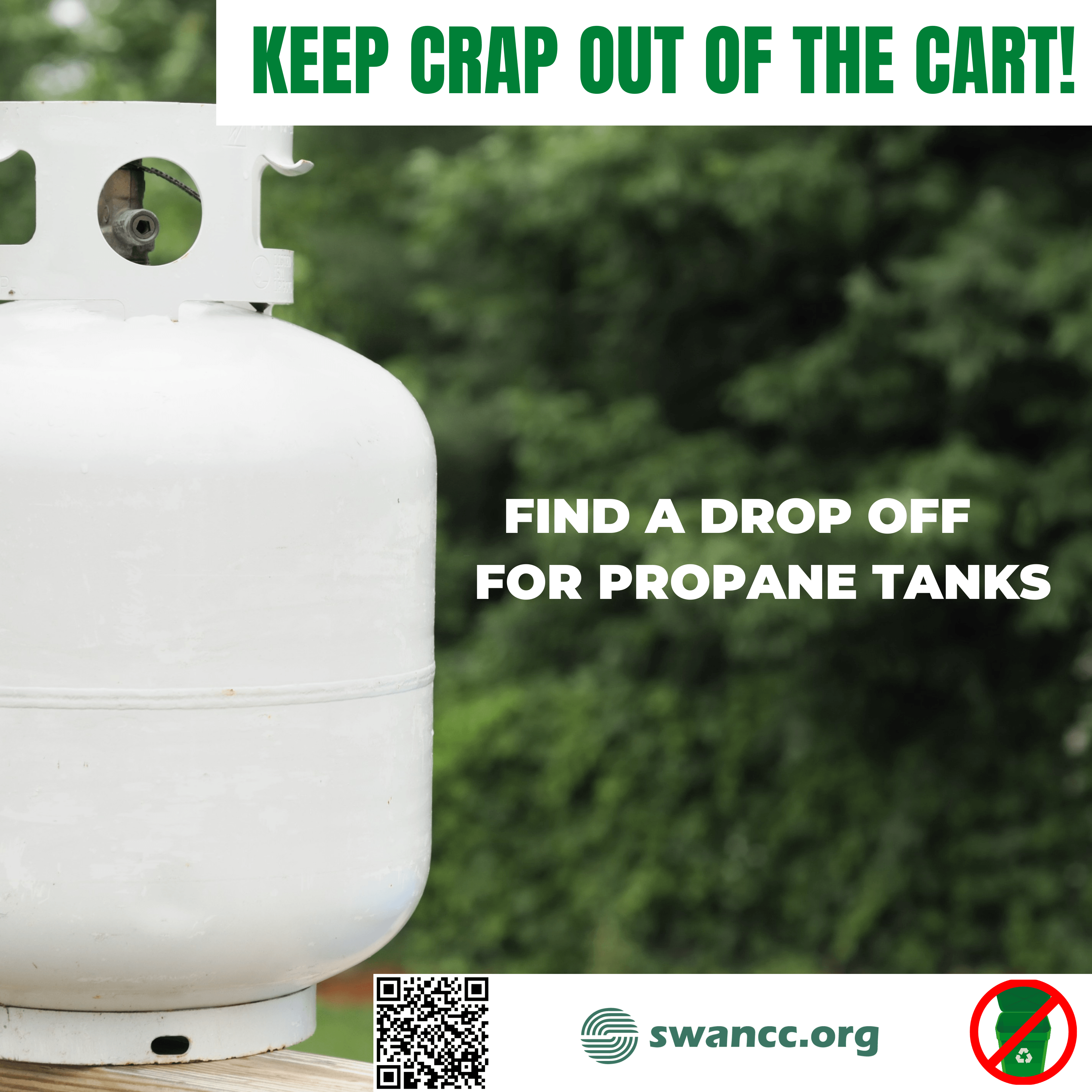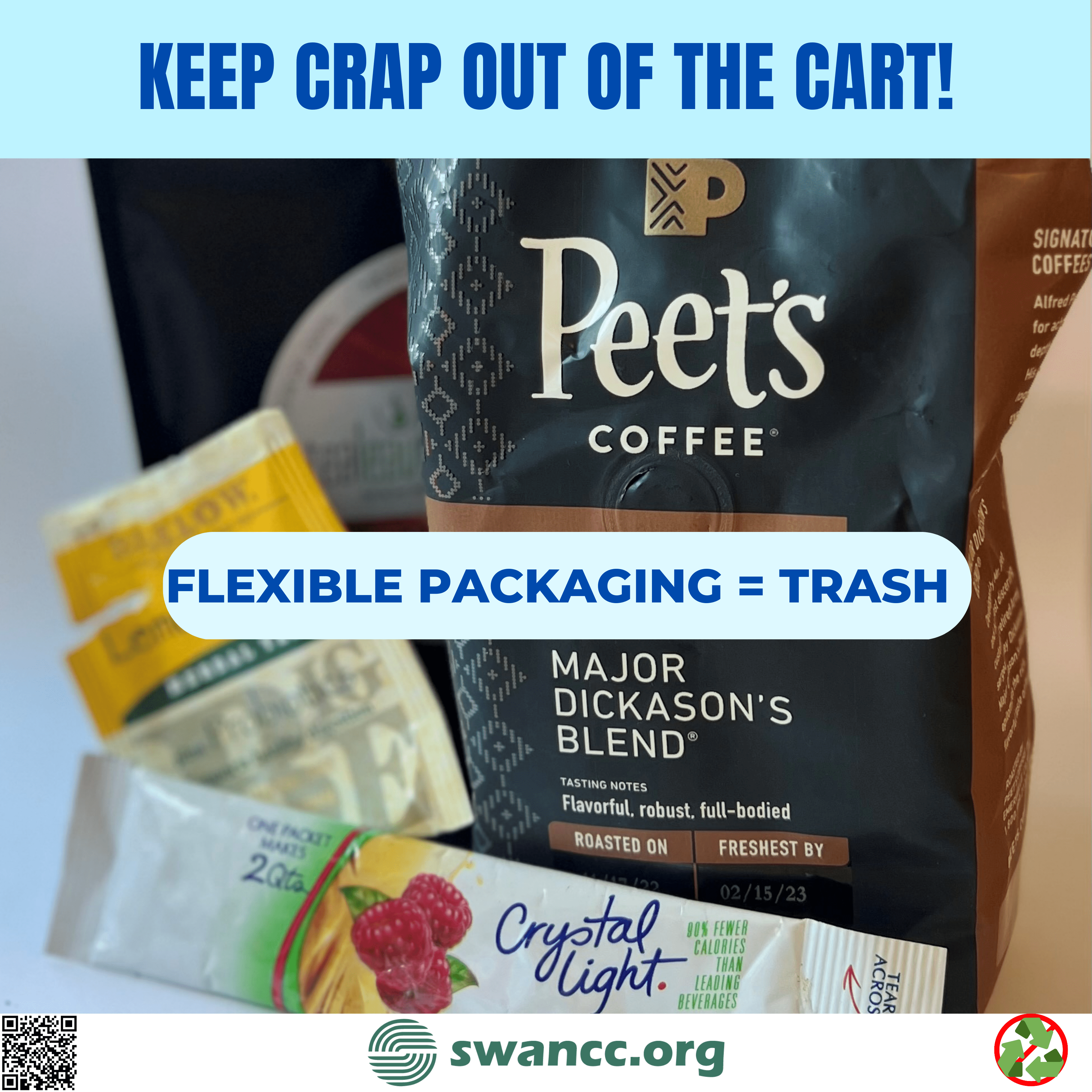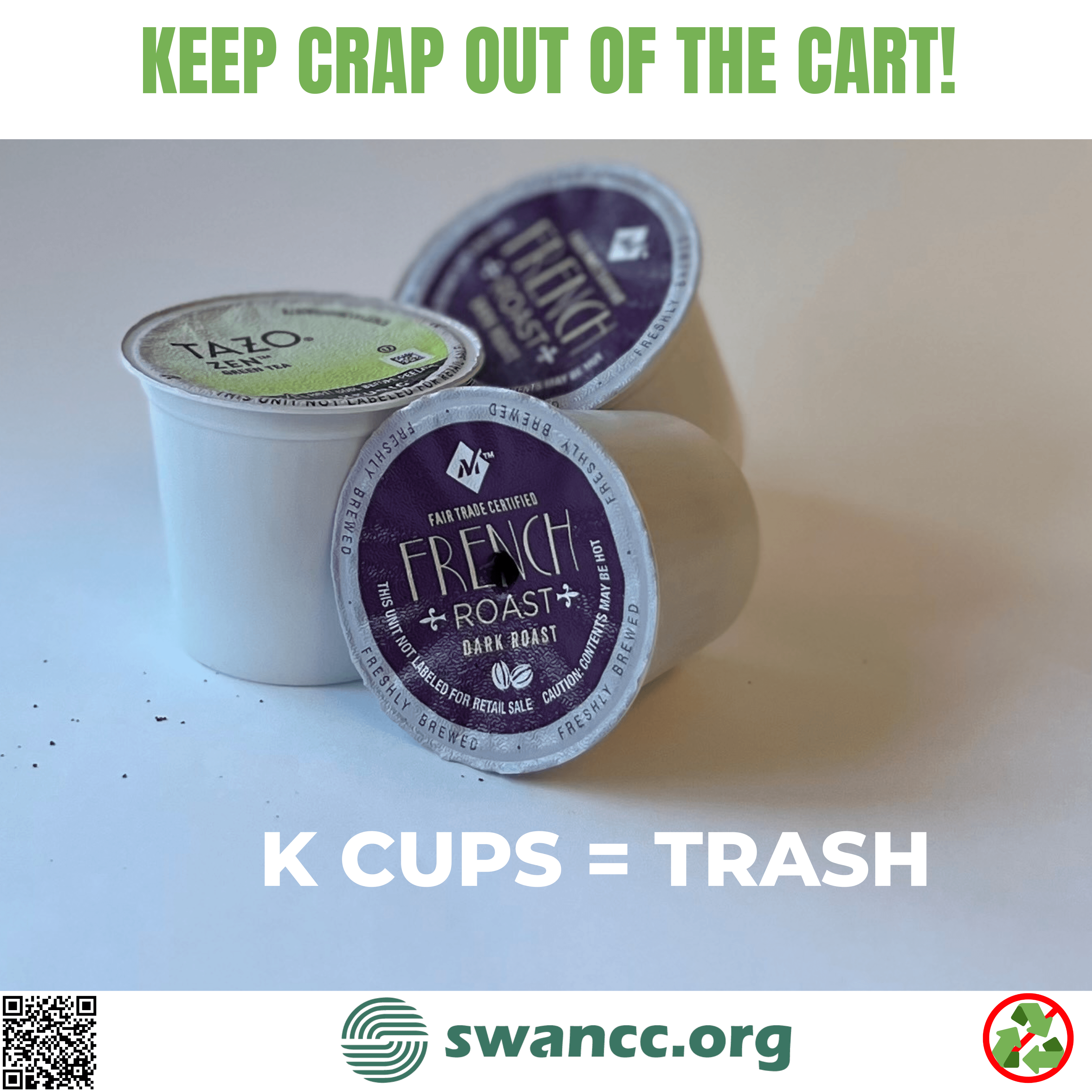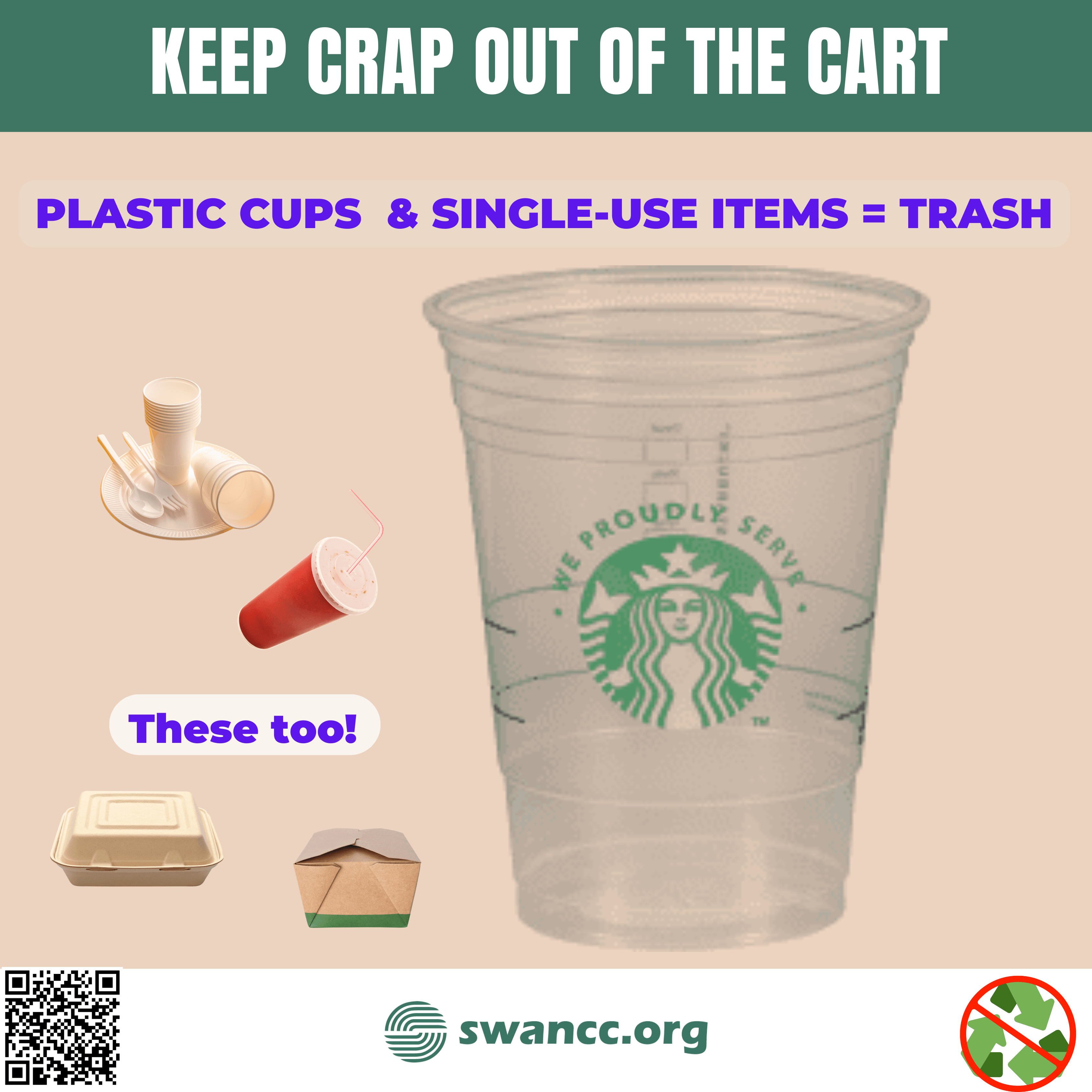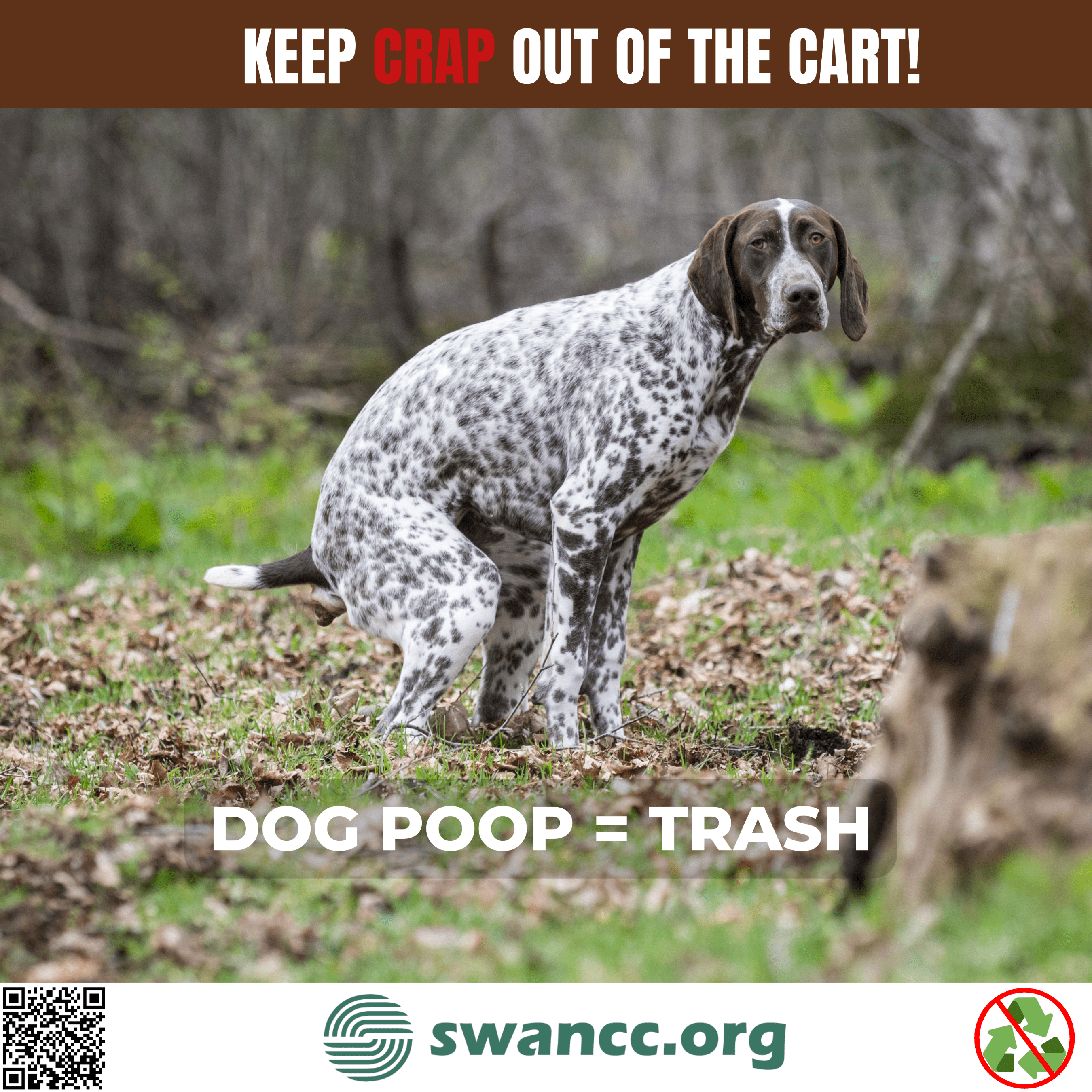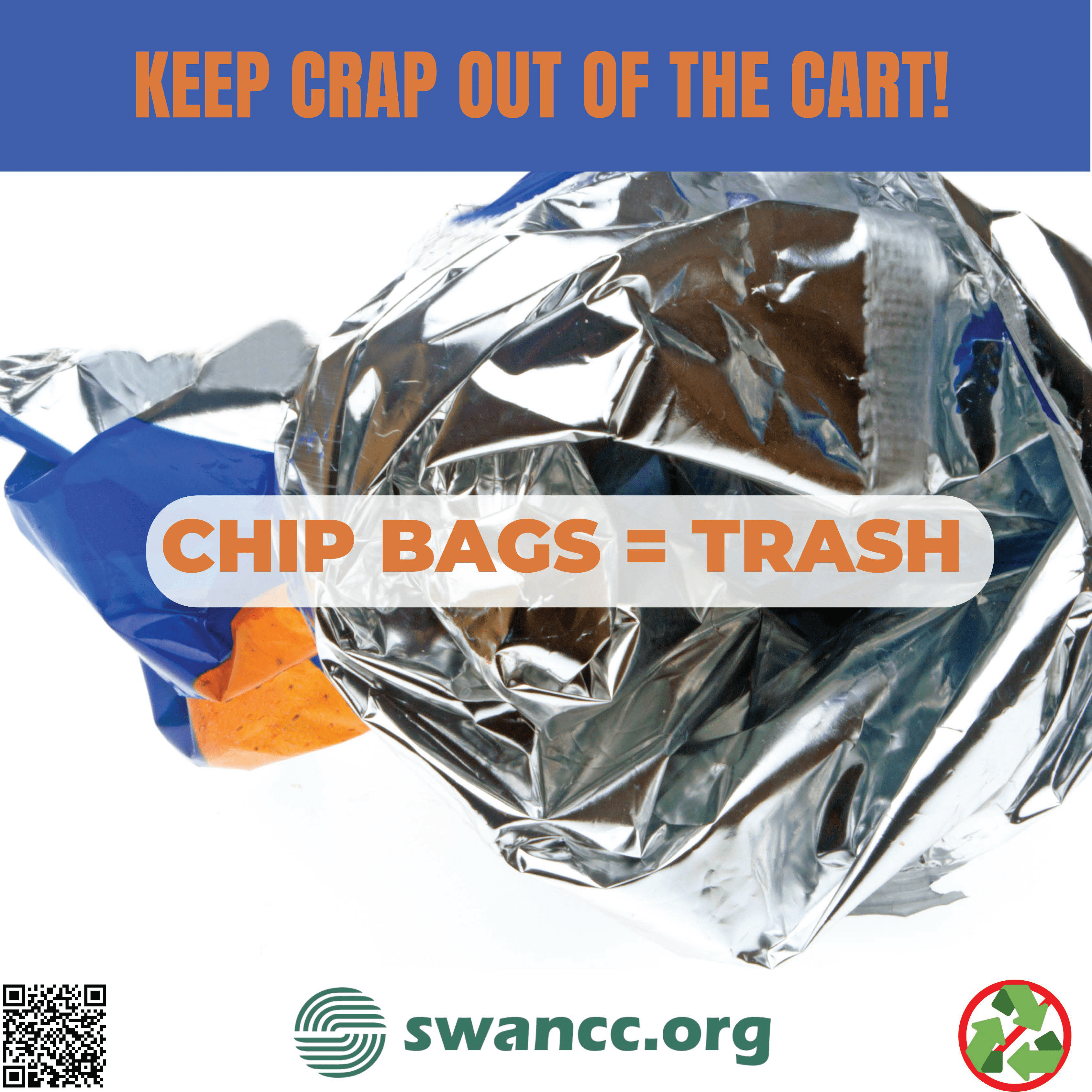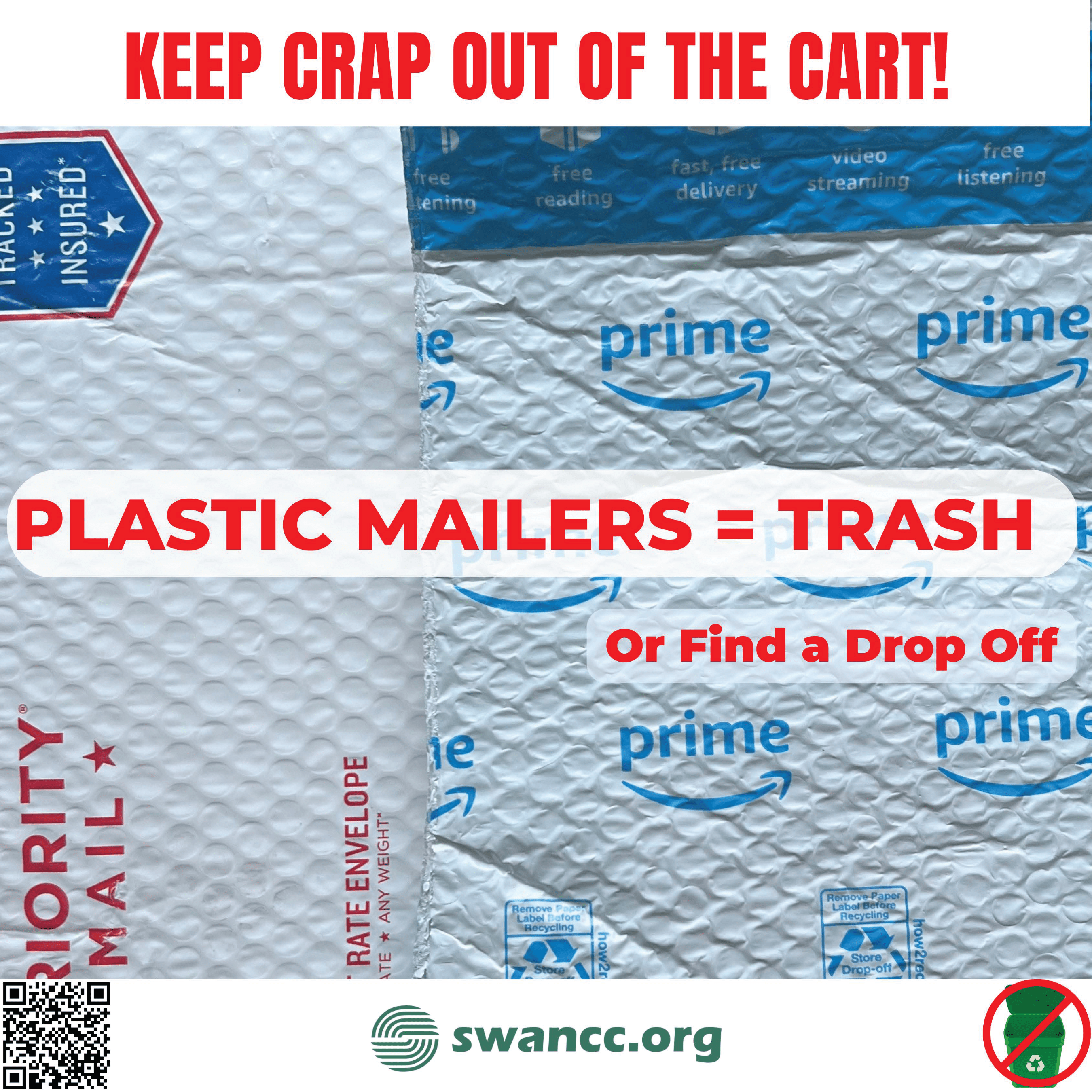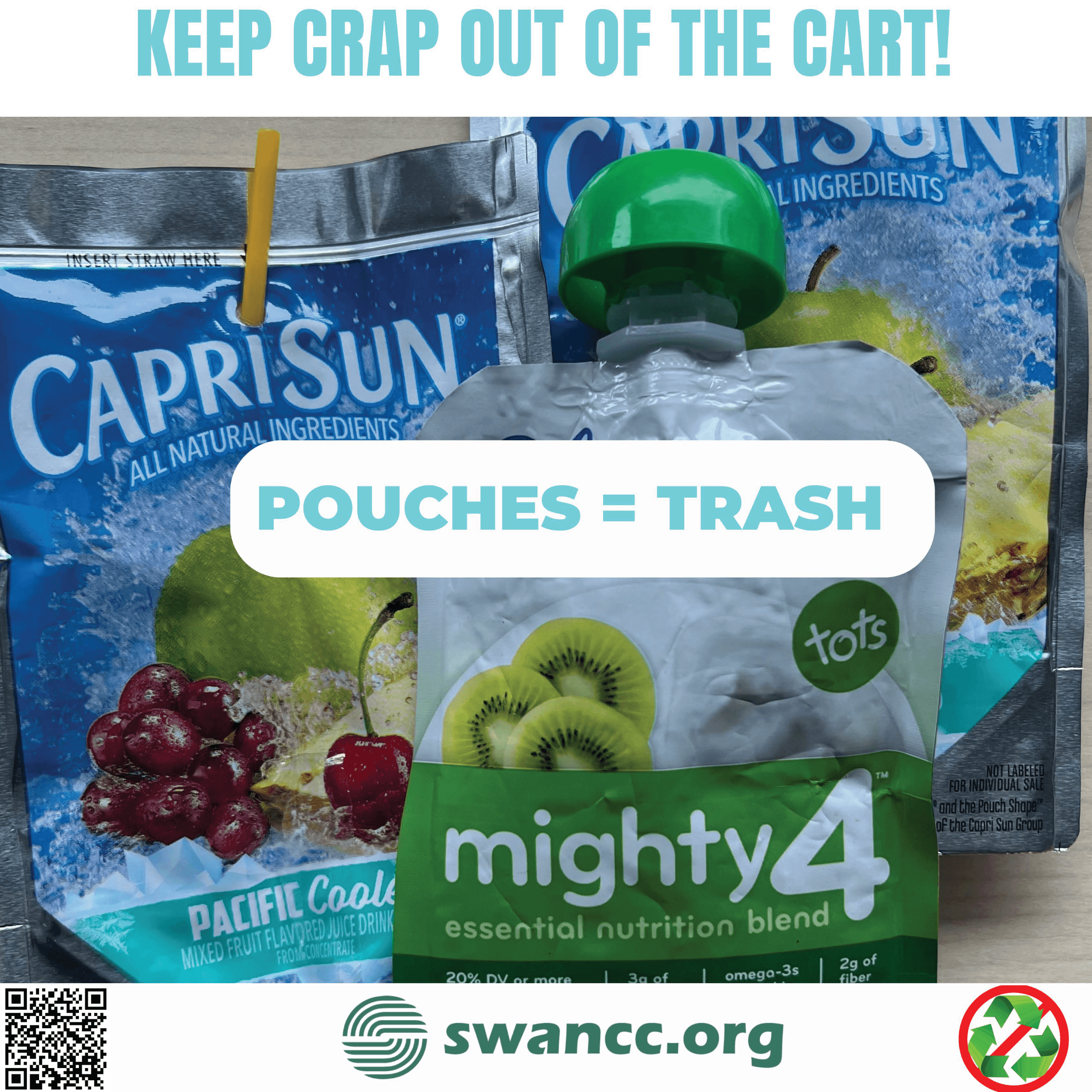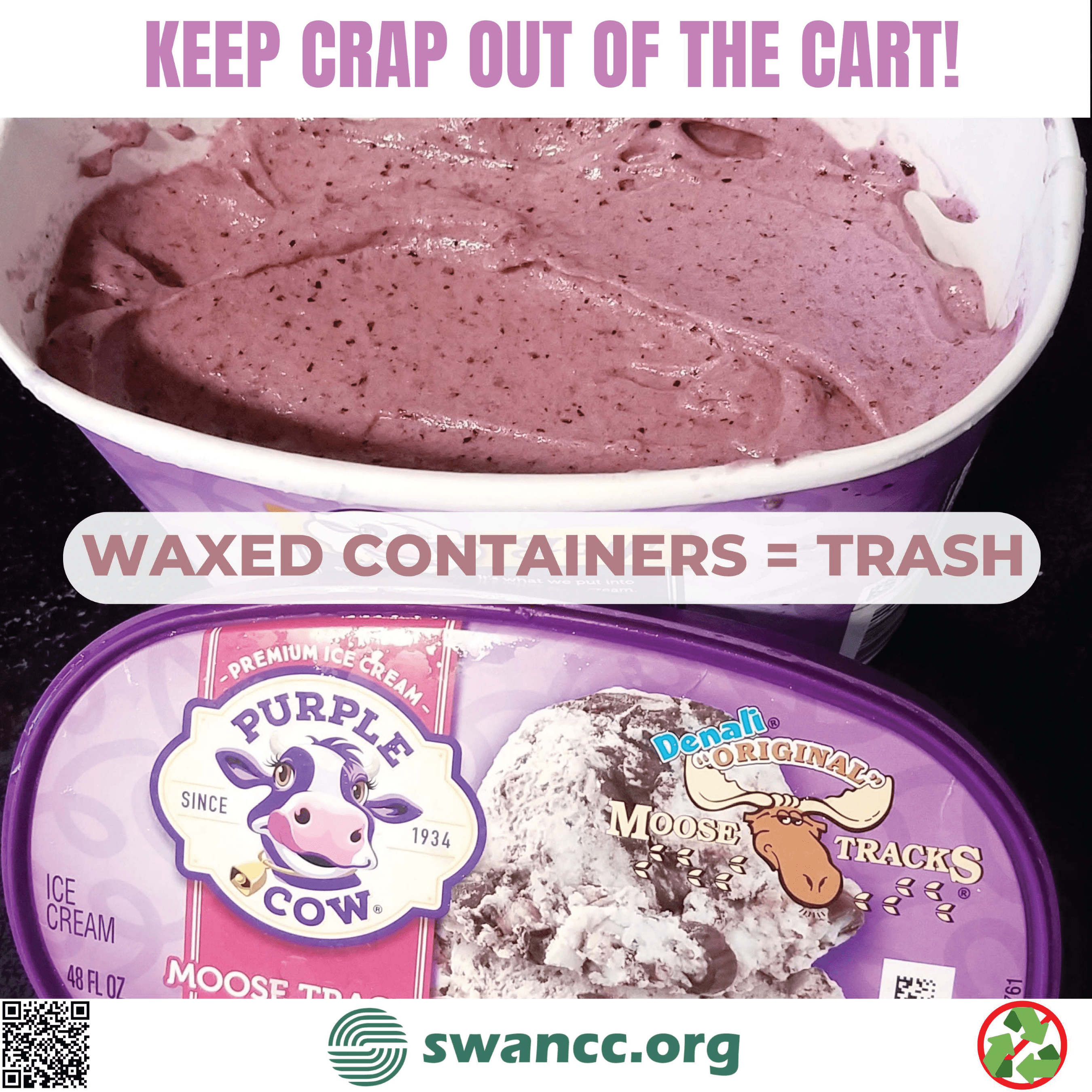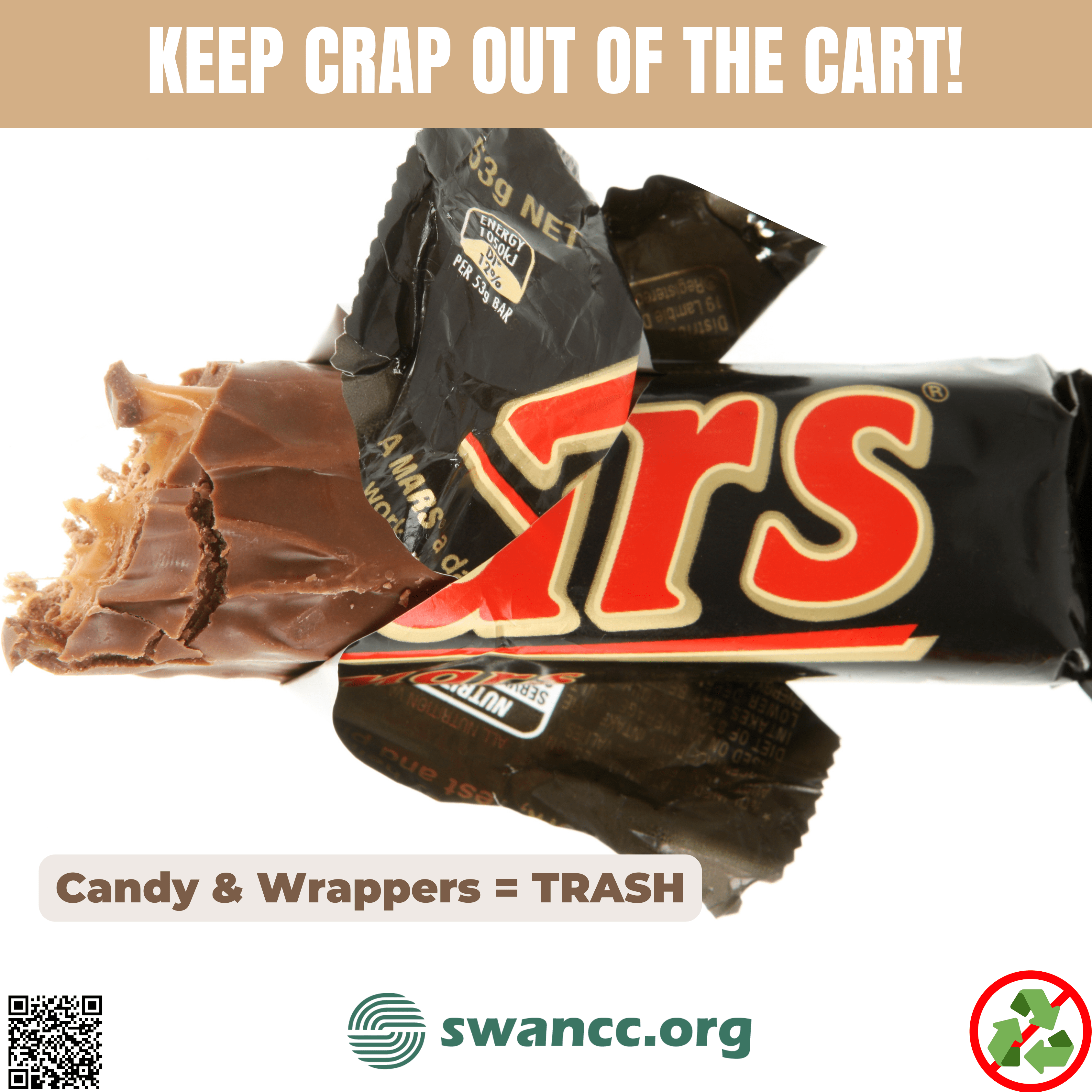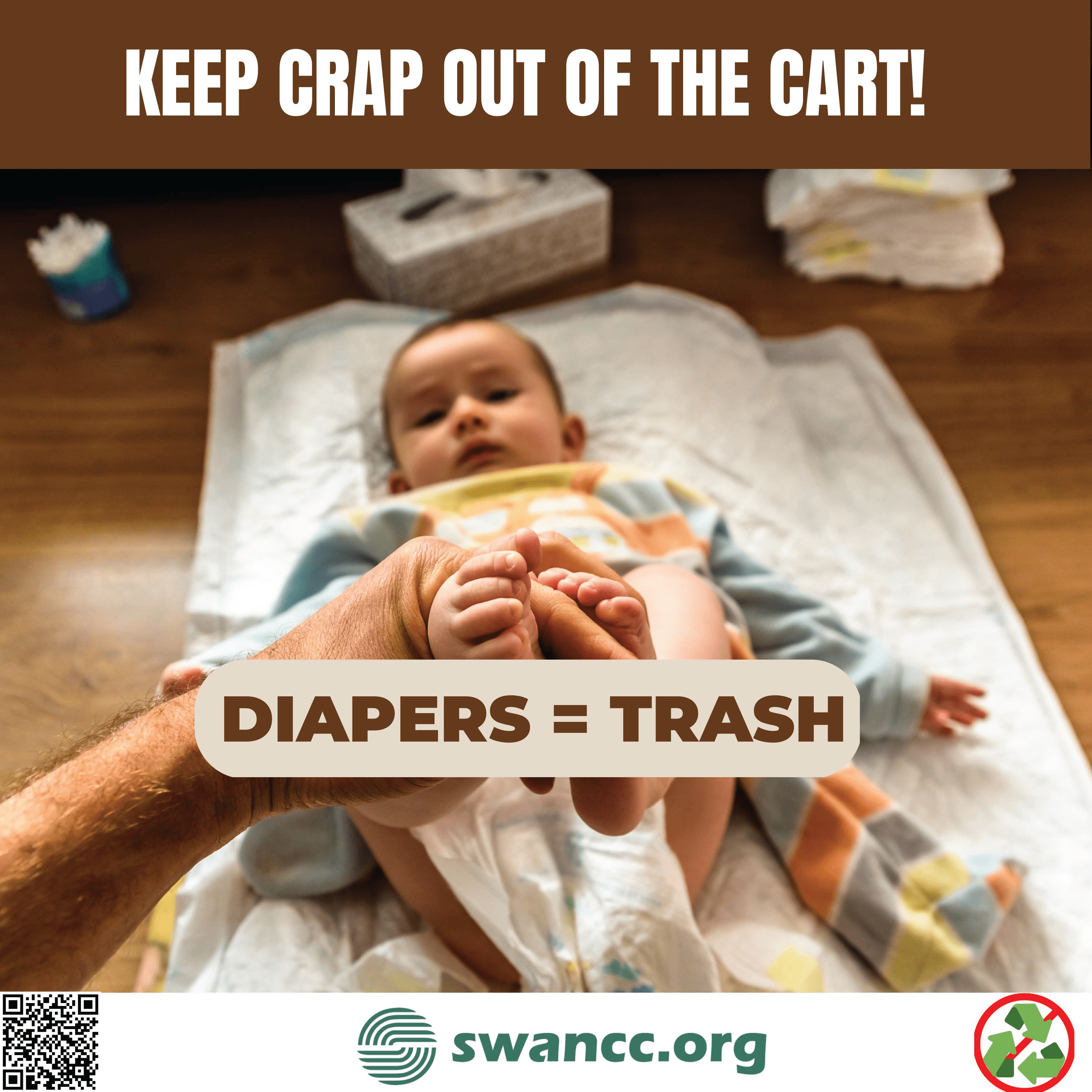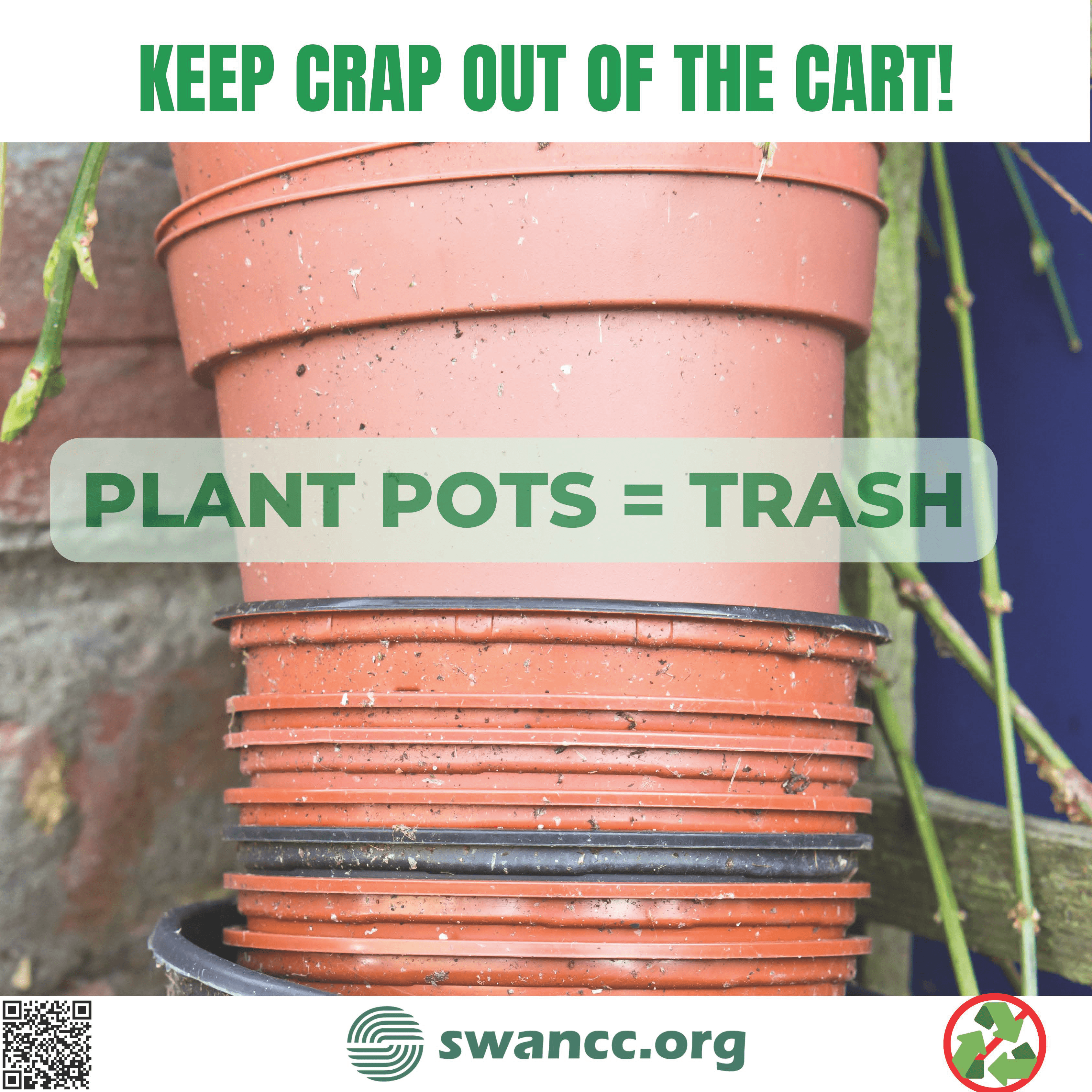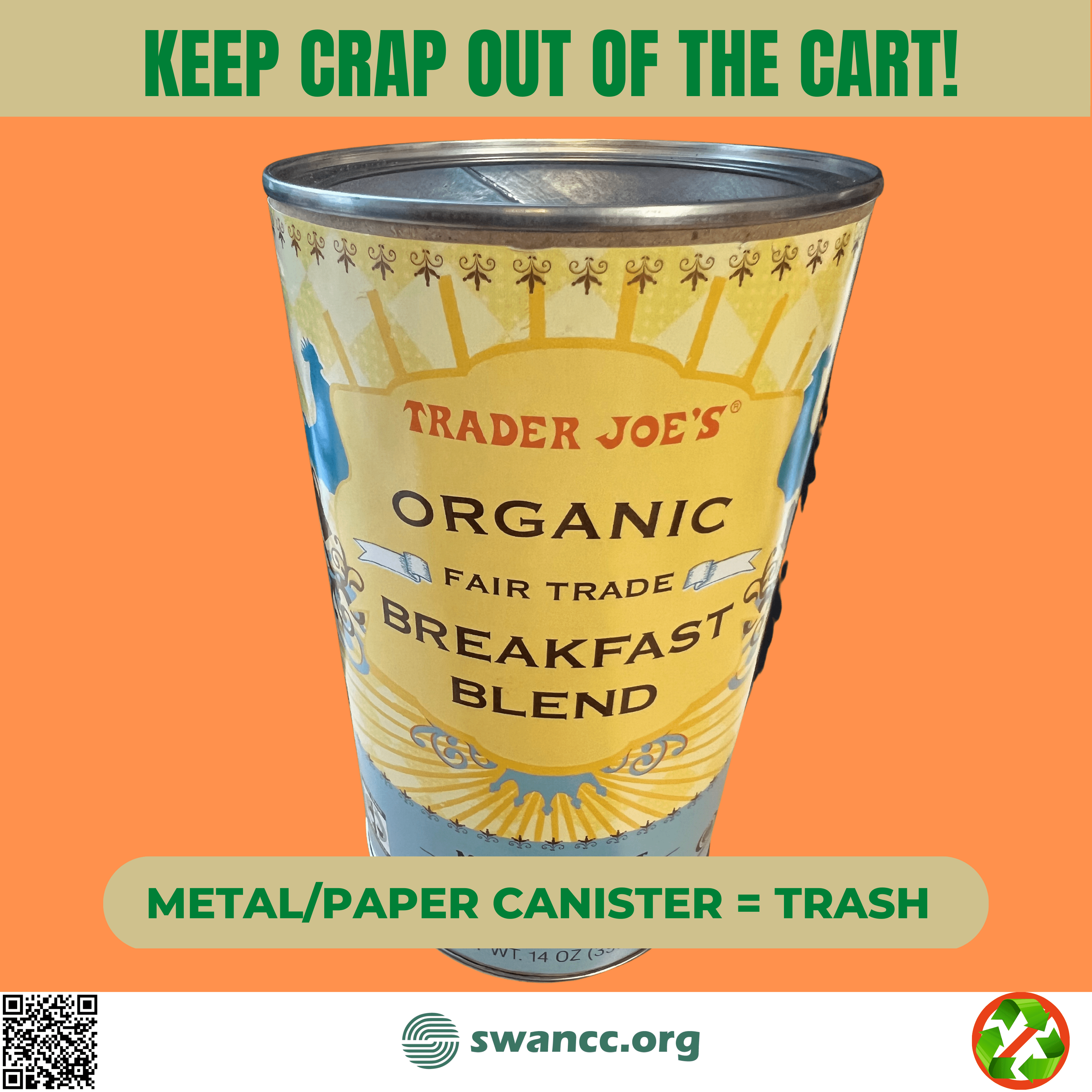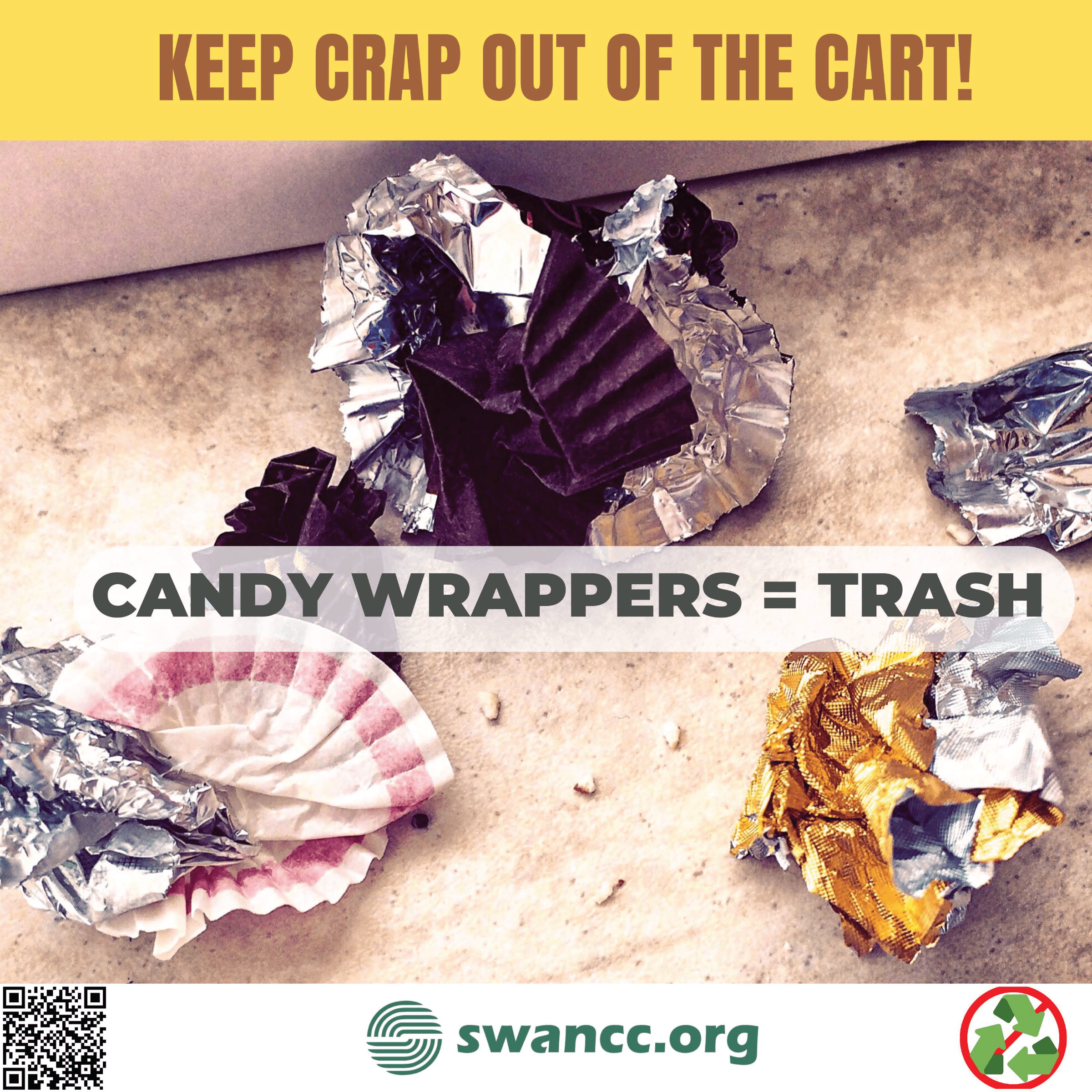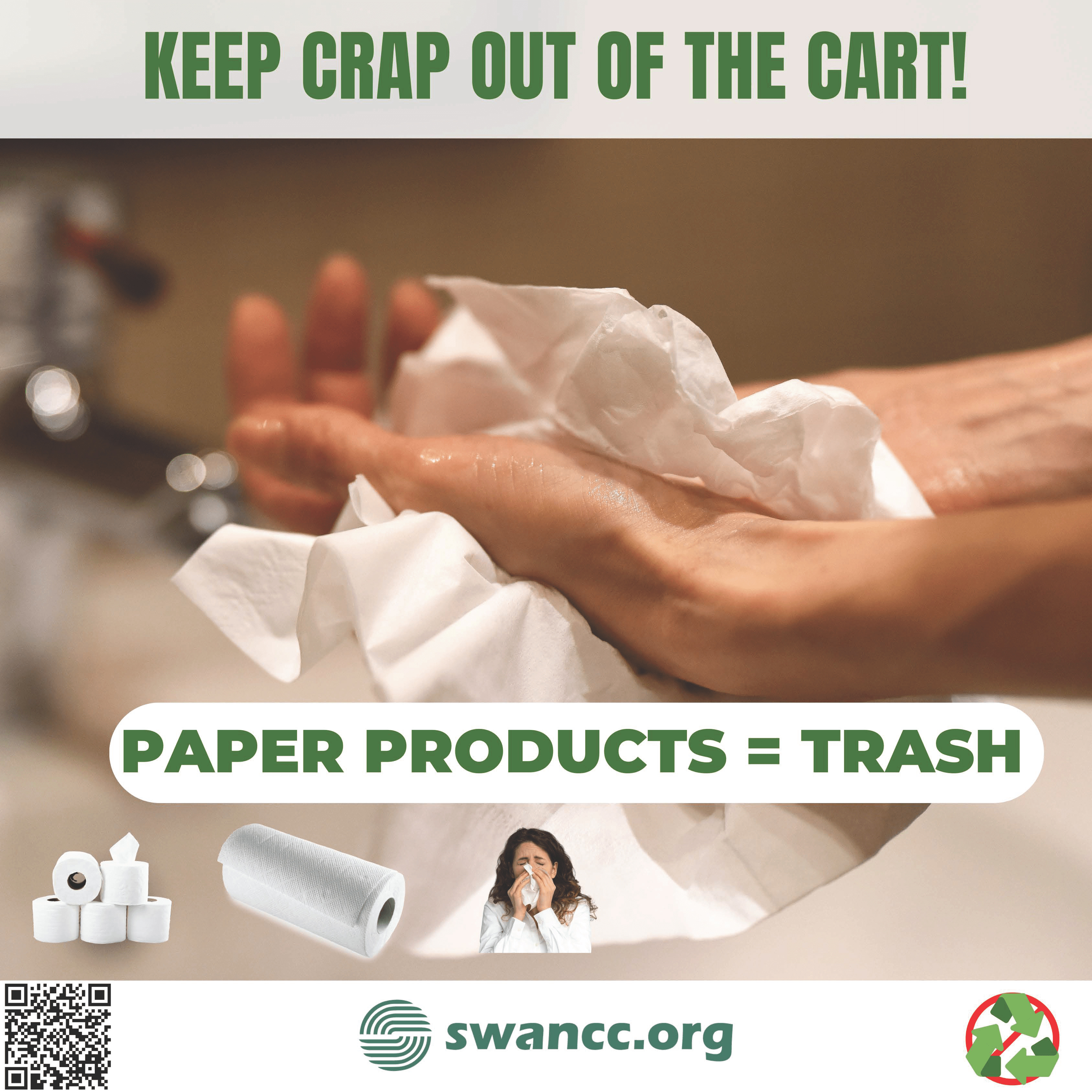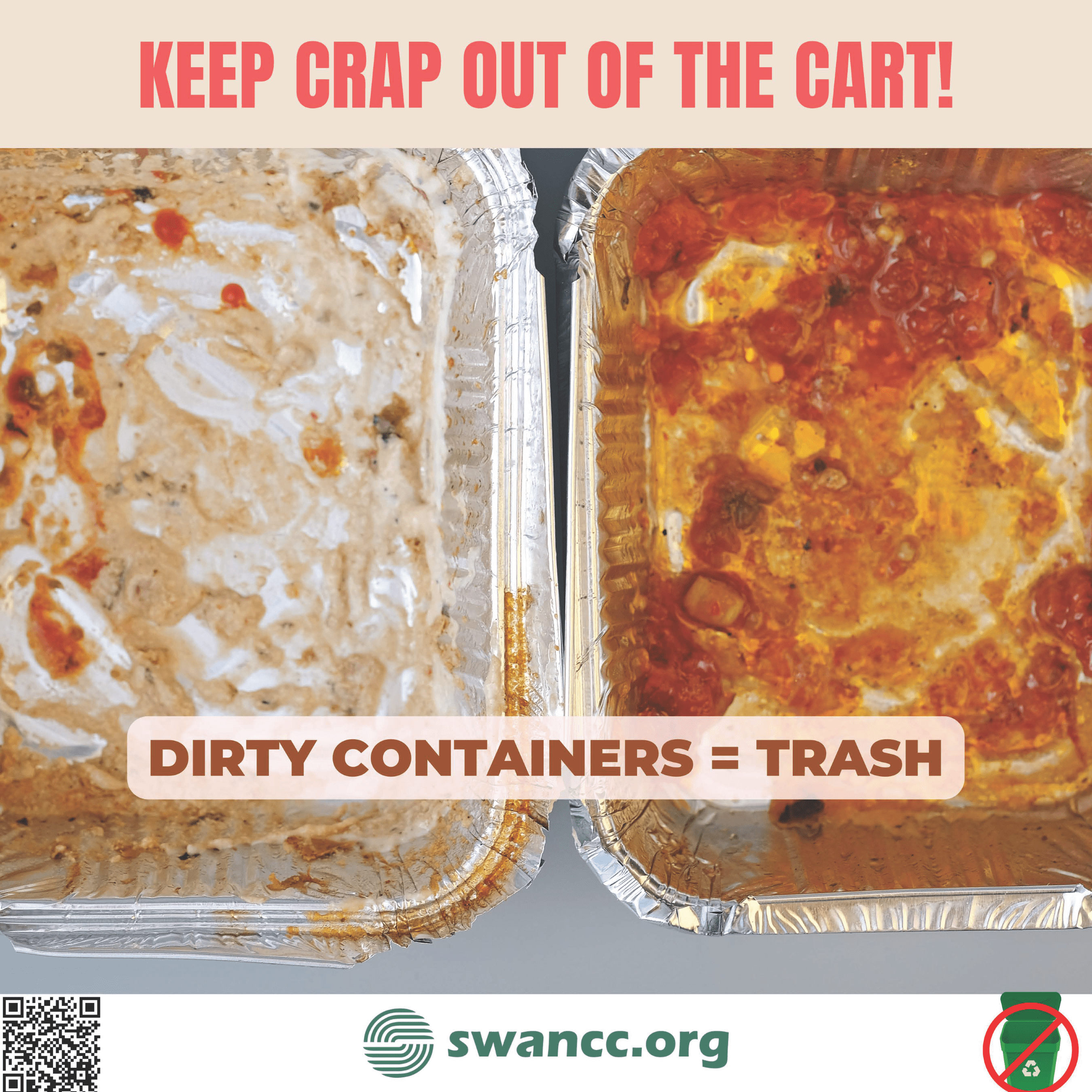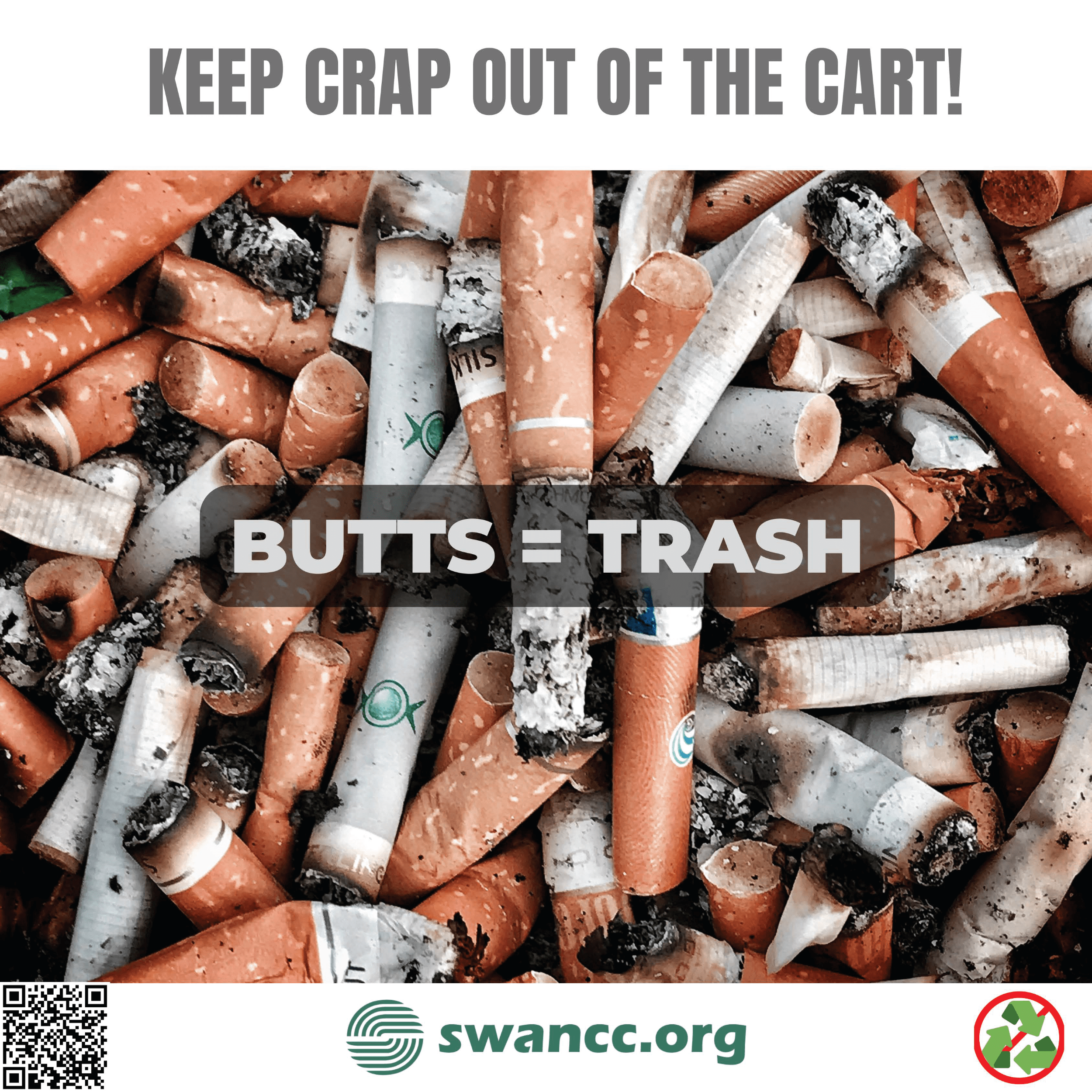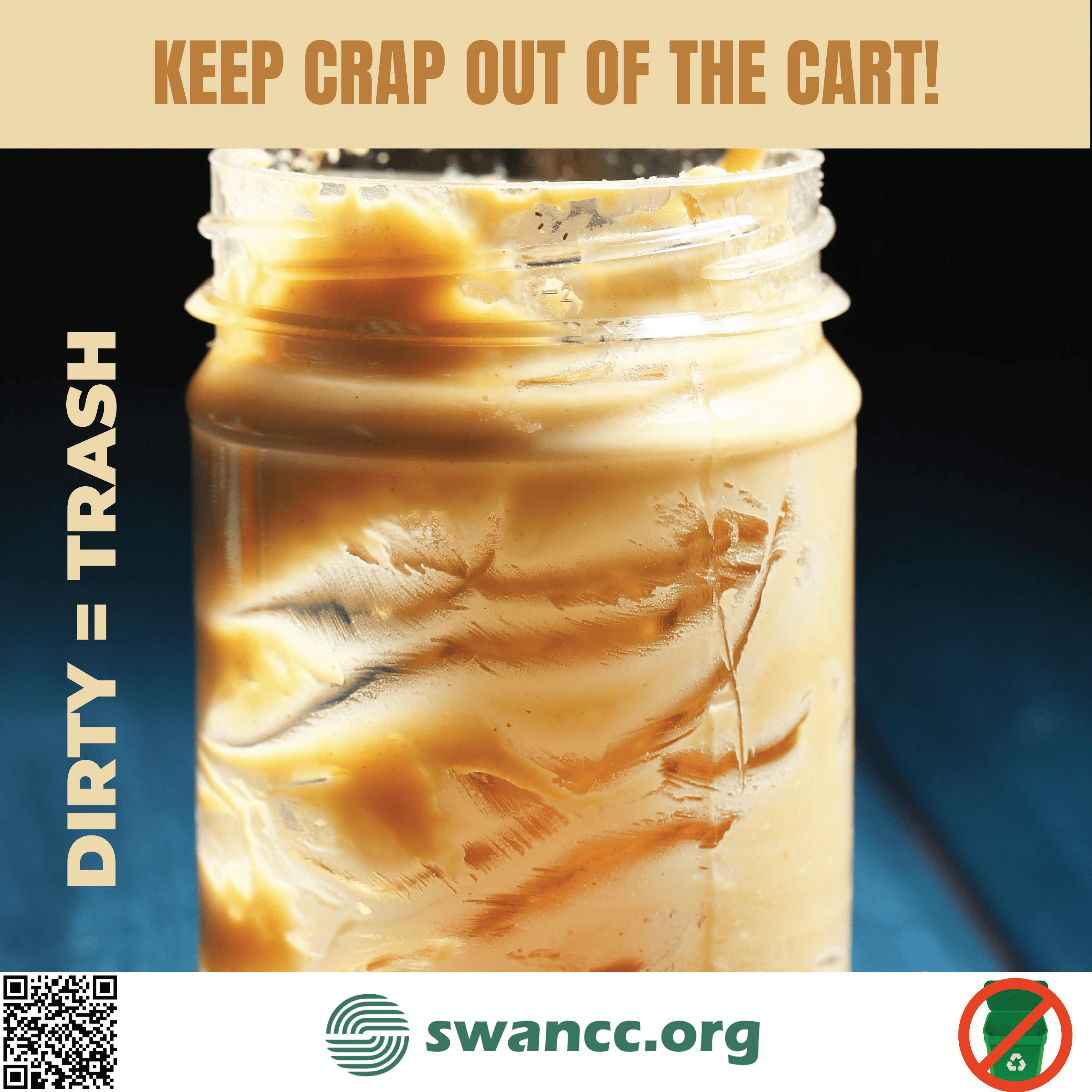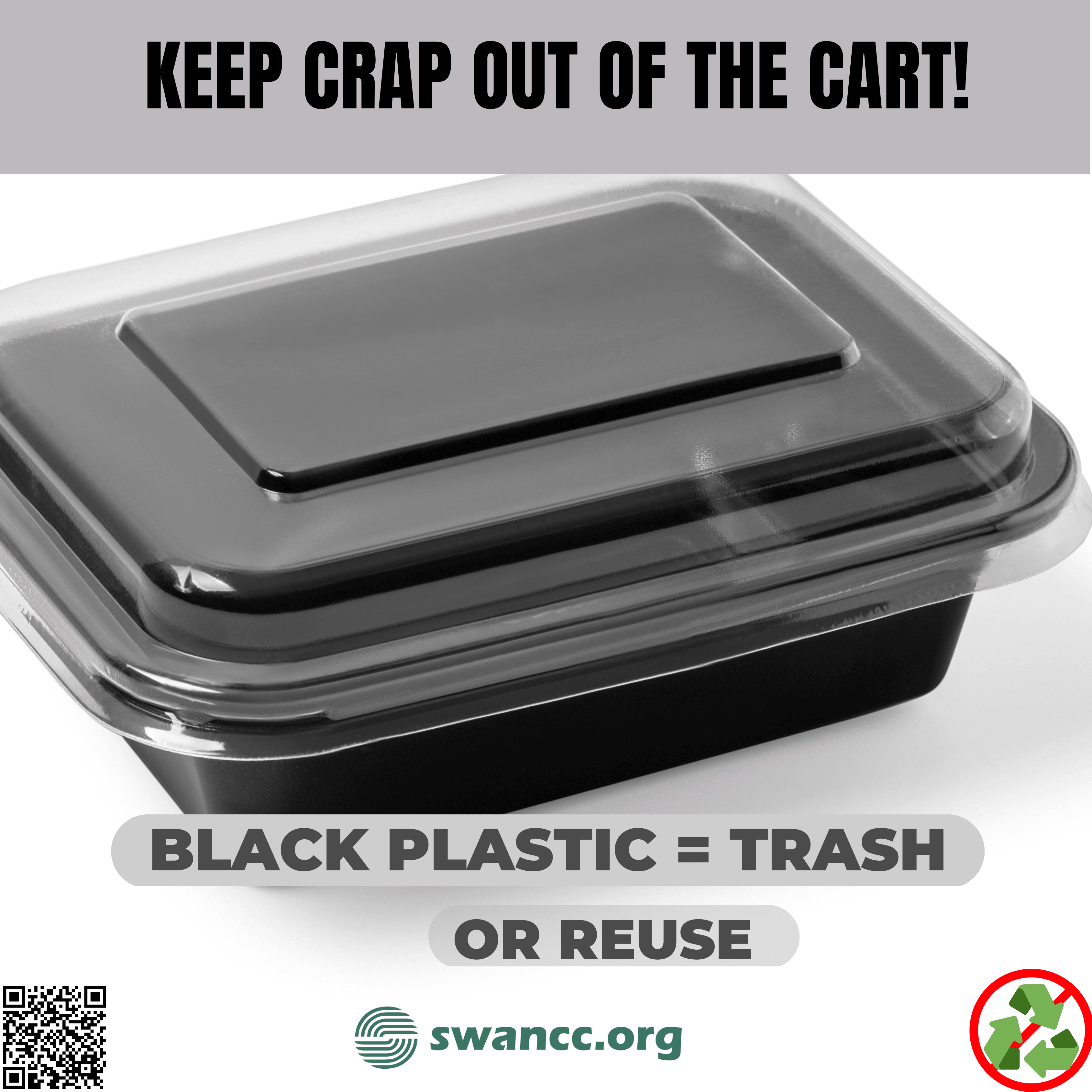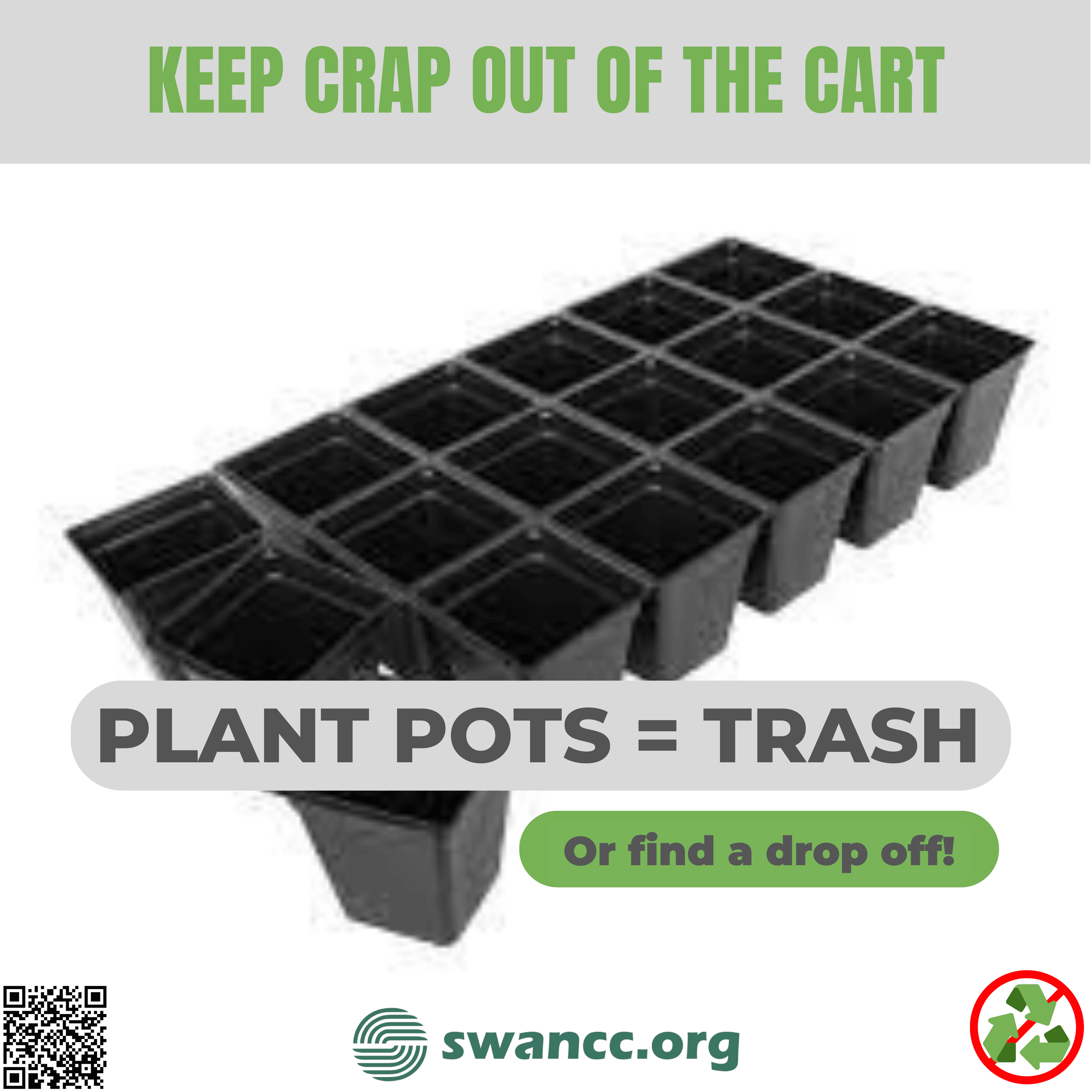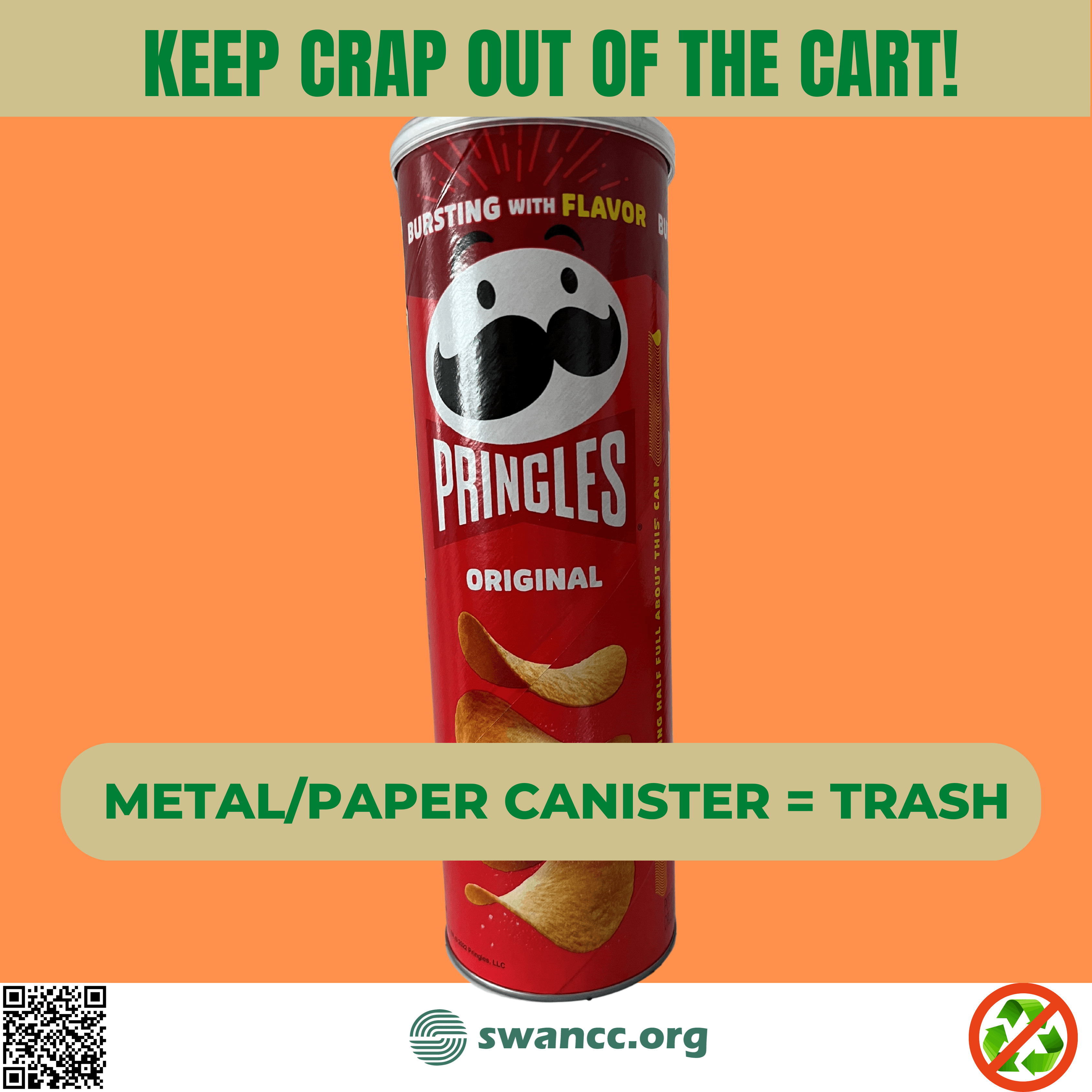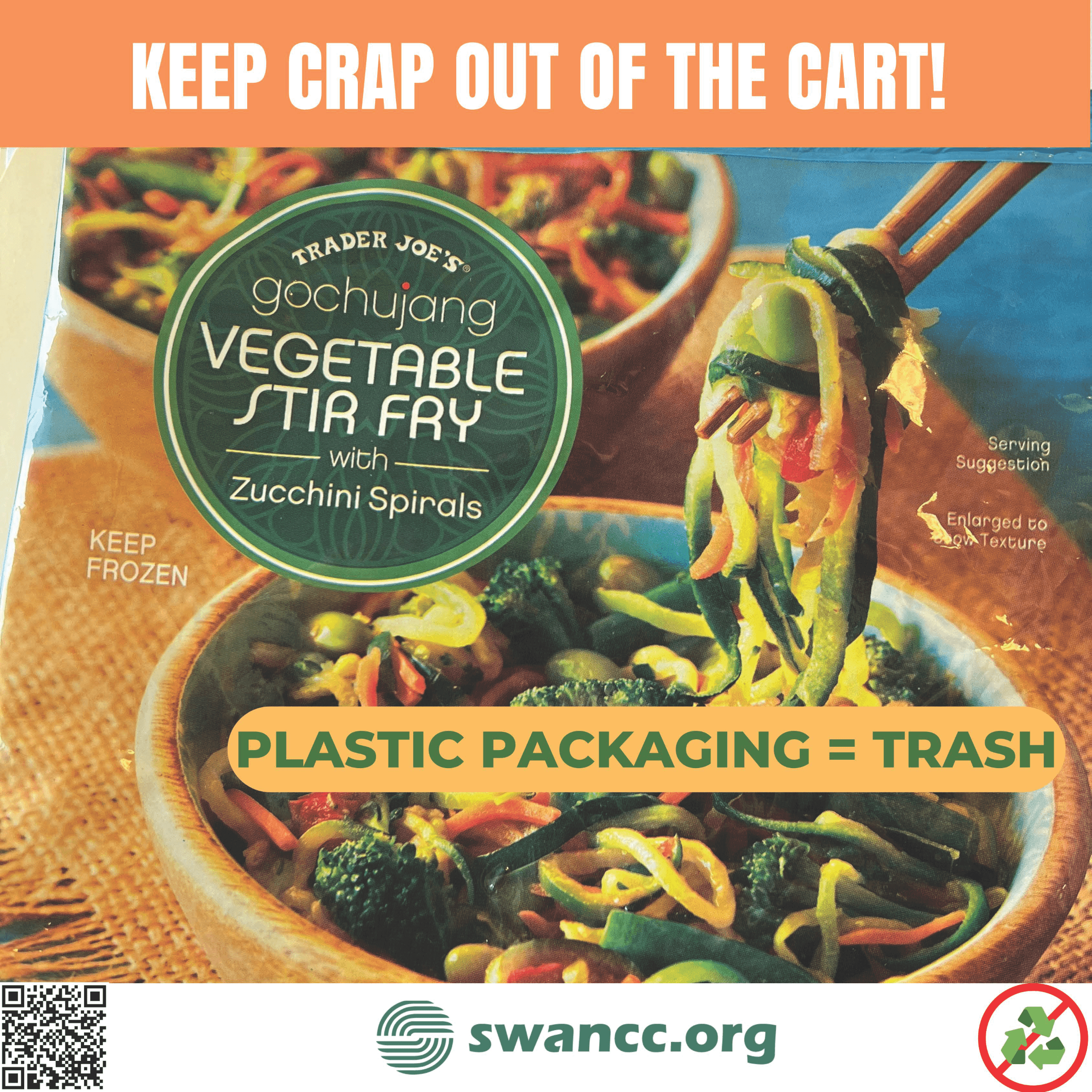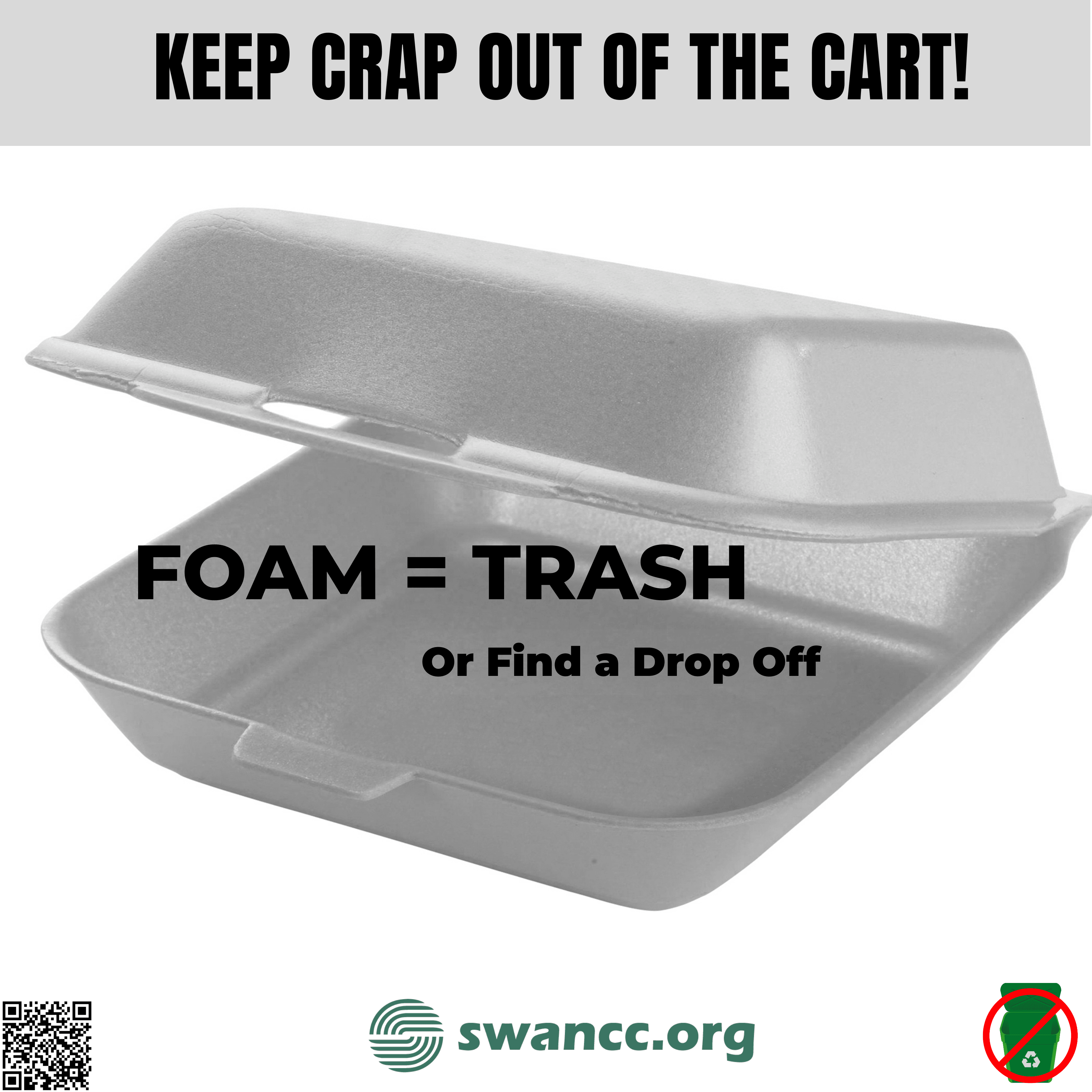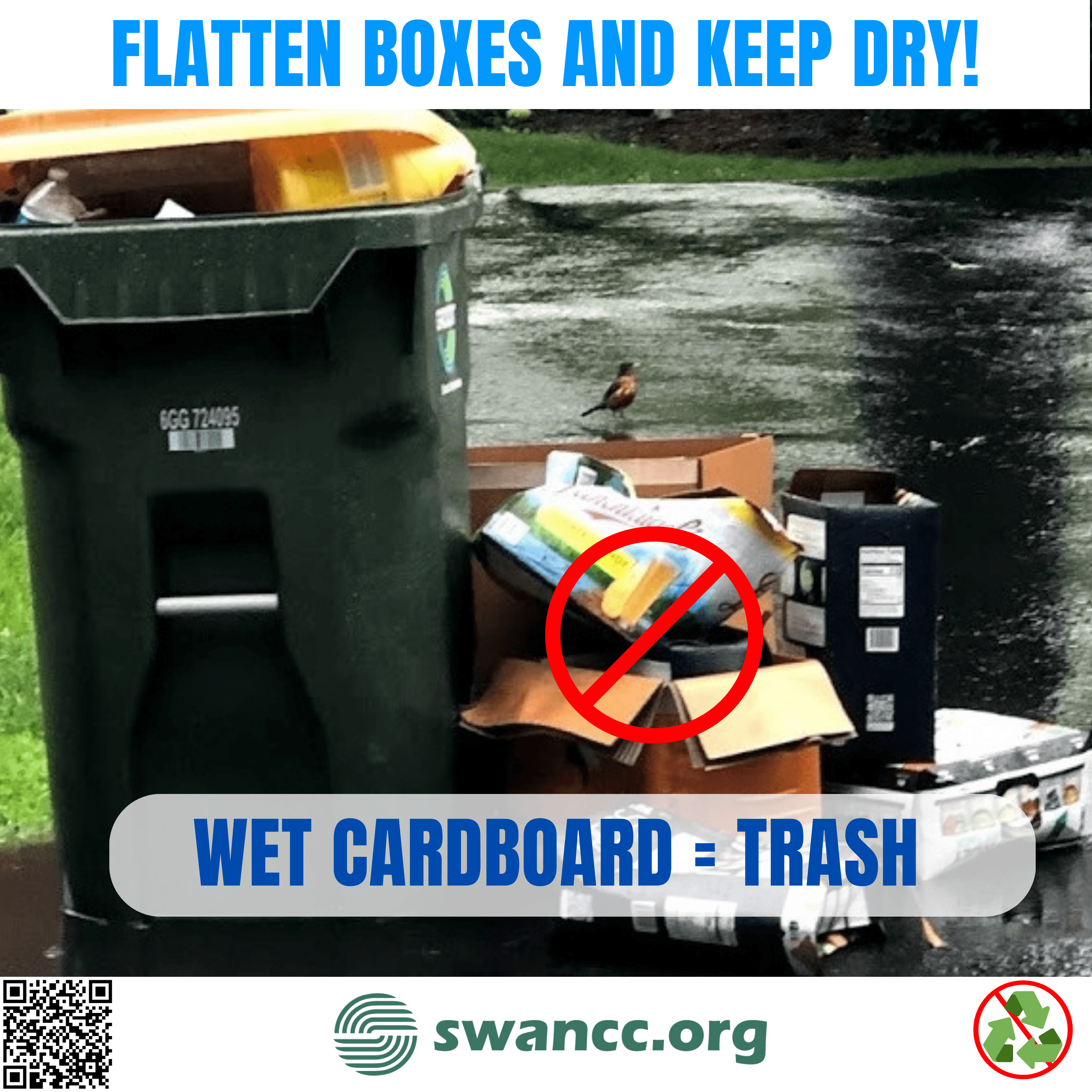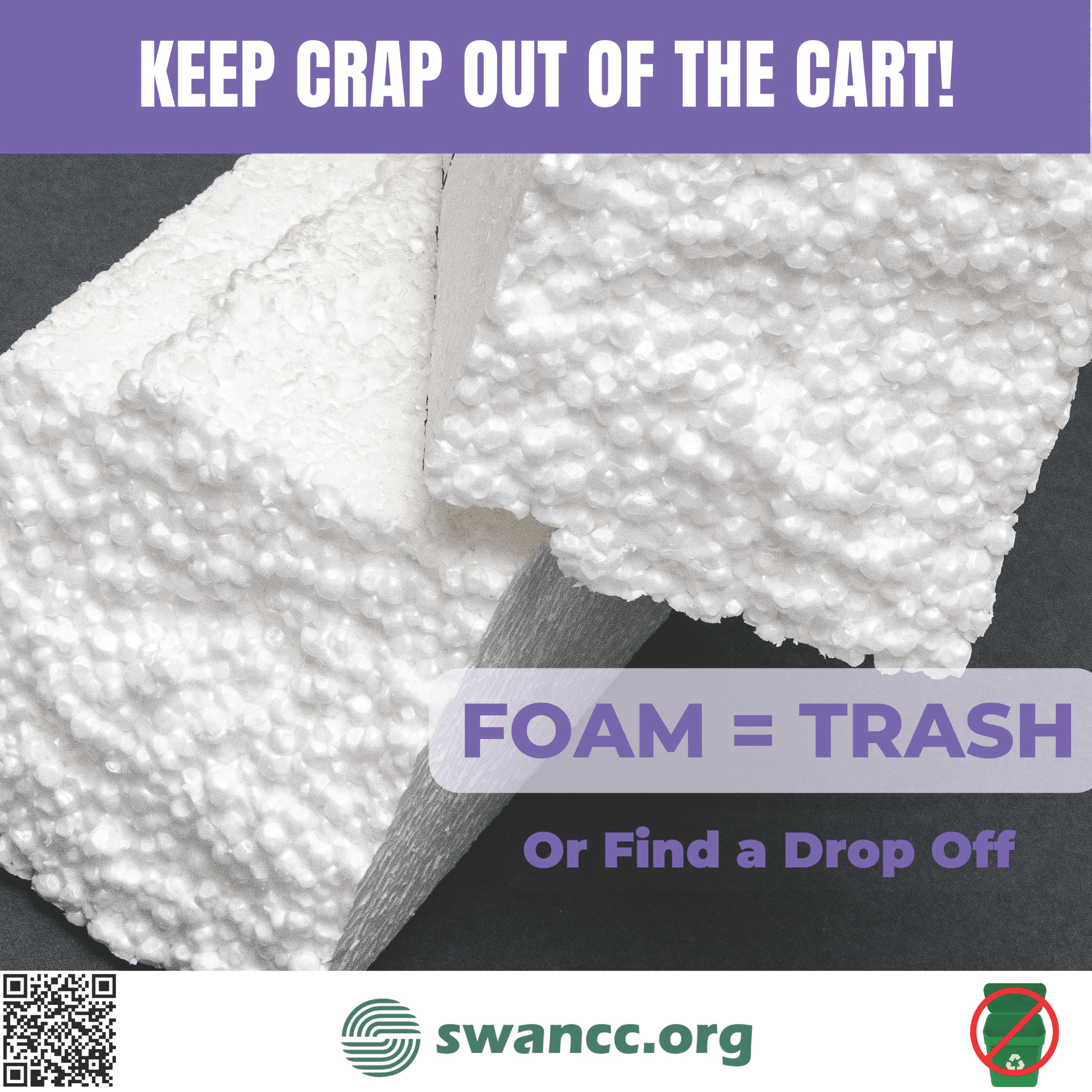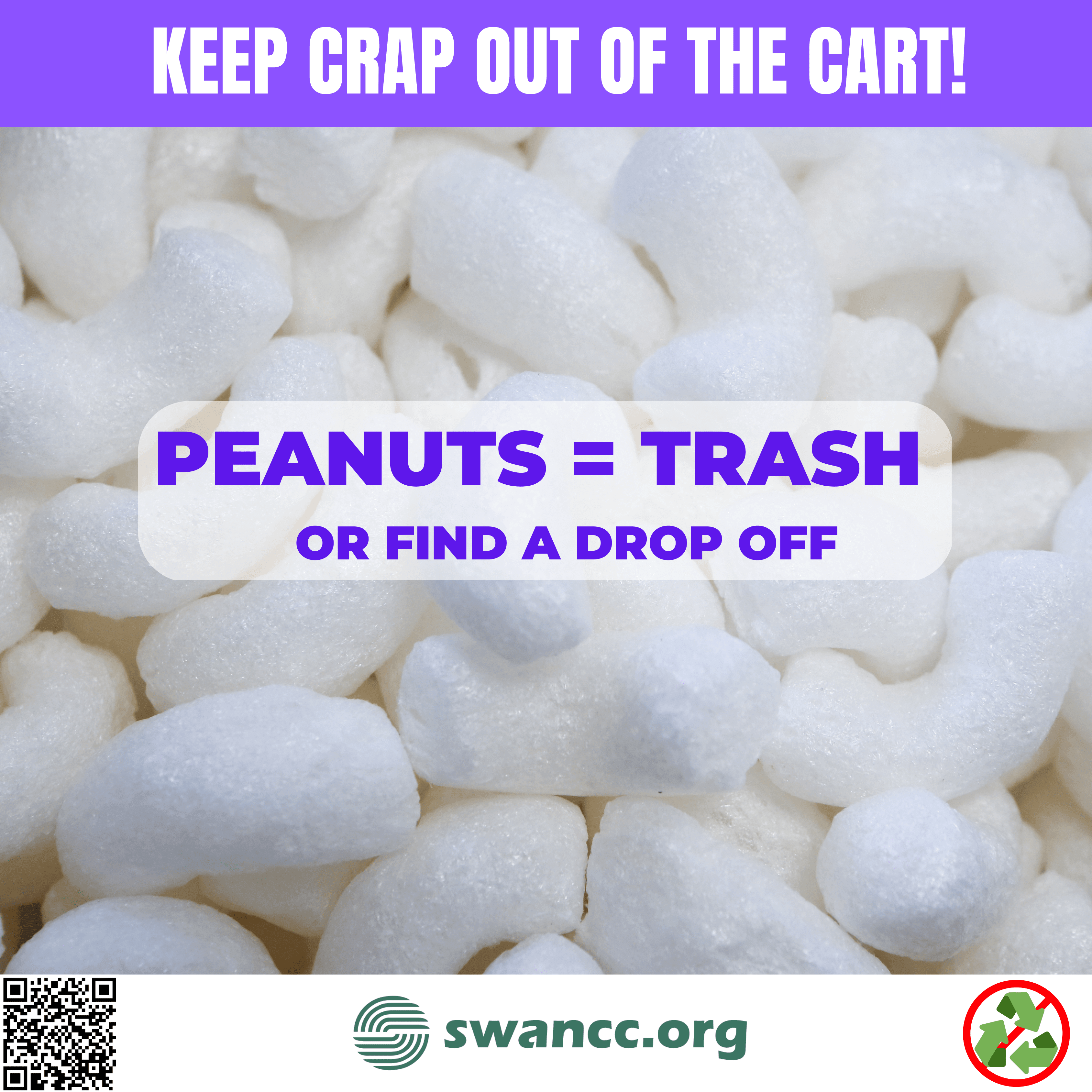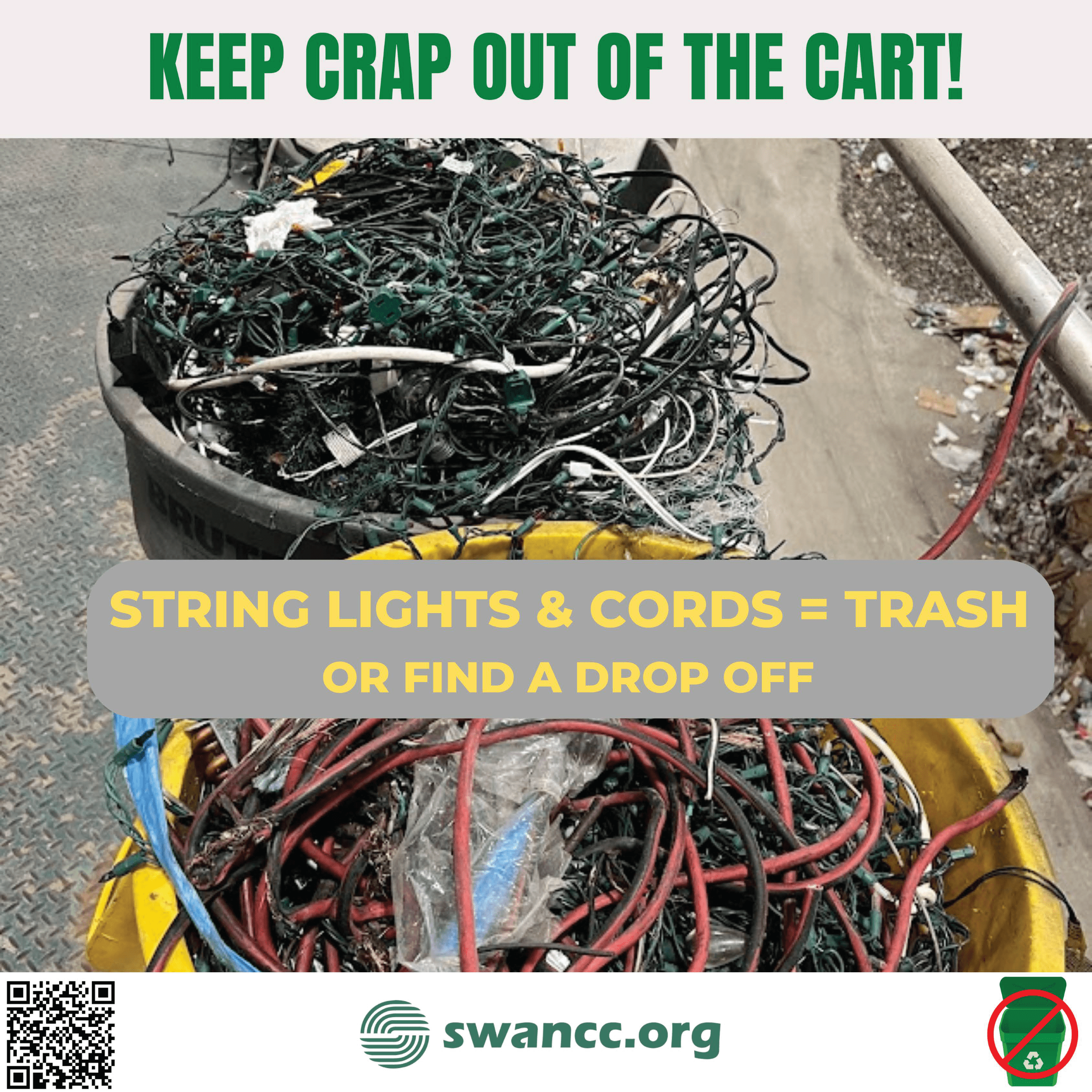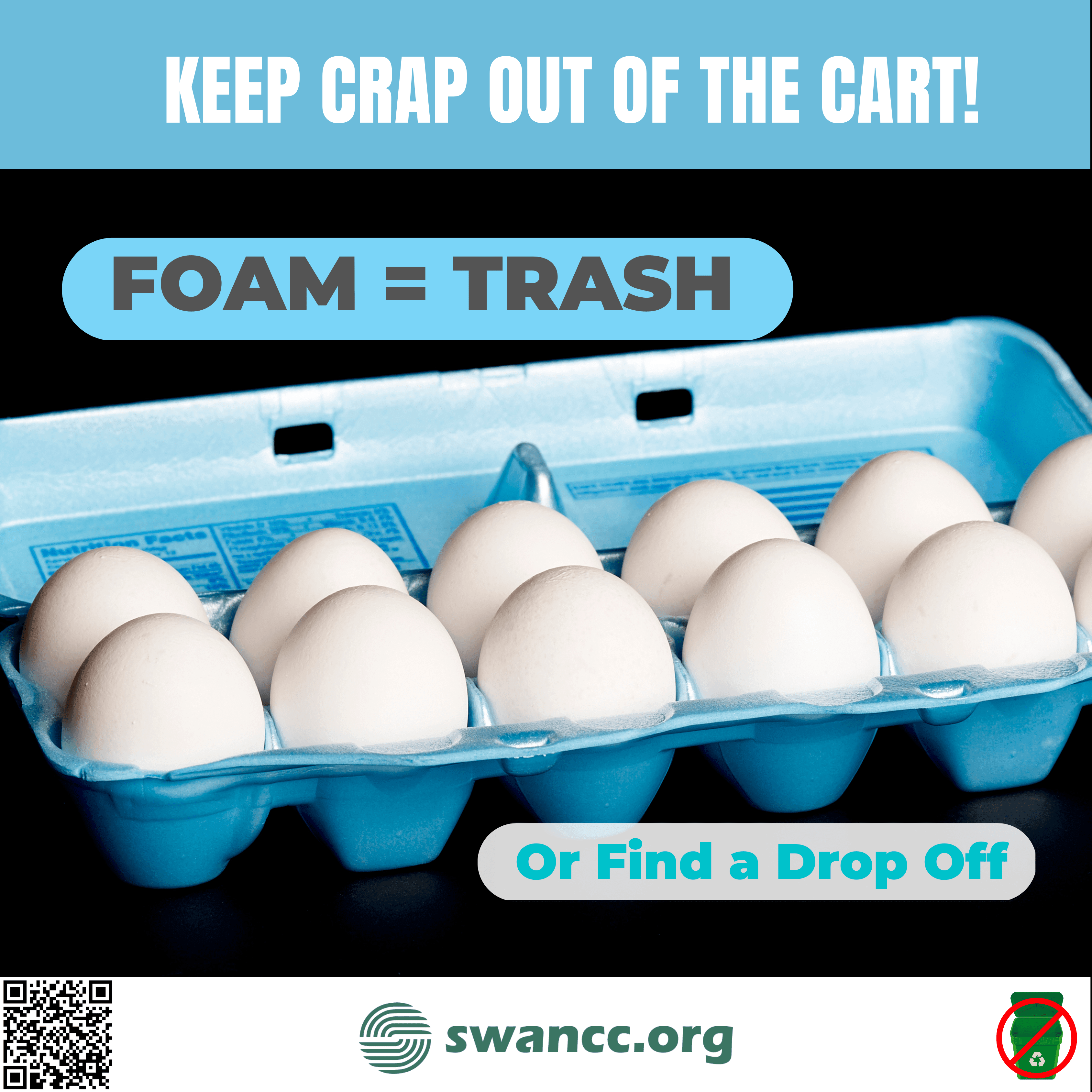For Earth Day 2023, SWANCC is rolling out a new social media campaign - KEEP CRAP OUT OF THE CART - on Facebook, Instagram, and Twitter. Follow us to like, share, and comment on our daily posts @swancc23.
KEEP CRAP OUT OF THE CART is focused on the items you SHOULD NOT put in the curbside recycling cart. Recycling contamination has devastating effects on the recycling stream and the environment, but knowing what belongs in the recycling cart or not is challenging. Contamination can be as simple as a plastic cup or a candy wrapper, but it can also be as dangerous as batteries (which can cause explosions and fires) or as disgusting as food and poop.
When people have the best intentions and try to recycle as much as they think they can, they can end up “wish-cycling”: placing items they think (or “wish”) can be recycled in their recycling bin. Wish-cycling contaminates otherwise good, recyclable items in the cart, requiring more processing at the recycling facility to remove the wish-cycled items - or worse, they don’t get sorted out and continue to contaminate materials sent to be made into new products. In the end, trying to recycle things that don’t belong in the cart can create more problems than not recycling at all.
A special note about plastics - Messaging and labels on plastic containers are confusing. The chasing arrows “recycling” symbol with a number does not indicate the recyclability of an item. The number symbol found on plastic items only indicates what type of plastic resin the item is made from, but that does not mean the item can be managed in the curbside recycling process. ONLY PLASTIC BOTTLES, JUGS, JARS, AND TUBS ARE RECYCLABLE! Many of these items have caps that assist in keeping the item’s shape so it is able to be detected by recycling equipment. (TIP: Keep caps ON plastic items before recycling them! It is no longer best practice to separate caps from bottles.)
See the entire campaign below, along with more information about why the materials are not able to be recycled and what to do with them instead.
Dangerous Materials
Plastic Bags = Trash
Just because they are plastic, does not mean they are recyclable. Plastic bags get tangled in recycling sorting equipment and have to be cut out which is very dangerous for sanitation workers. Solution: Take plastic bags to a retail store drop off. This includes shopping bags, produce bags, food storage bags, bread bags, and newspaper bags.
Find a Drop Off For Needles & Sharps
Putting needles in the recycling bin is very dangerous to sanitation workers! Any needles used for medical or recreational purposes should not be thrown in your recycling bin EVER or thrown into your trash bin loose. Solution: Find a sharps collection program for medical waste to safely dispose of needles. Many SWANCC communities provide collection containers and collect full containers - check with your community, or search “Sharps” in SWANCC’s Reuse and Recycling Directory.
Bagged Recycling = Trash
When you put your recyclable items in a bag, they will all go to the landfill. Recyclers get thousands of pounds of recycling per day and do not have the staff or time to open bags of materials. Plus, plastic bags get tangled in recycling sorting equipment and have to be cut out which is very dangerous for sanitation workers. Keep materials loose! If you bag your recyclables in the house, empty the contents of the bag at your cart and reuse the bag.
Find a Drop off For Batteries
No batteries can be recycled in your curbside cart. They are too small to be detected by sorting equipment. Lithium batteries are also potentially explosive! The chemicals within rechargeable batteries are highly reactive, and even one tiny battery can cause a huge fire or even explosion! Solution: Alkaline batteries can be put in the garbage or taken to a battery recycling program. Lithium and other battery chemistries should NOT be put in the garbage - instead, find a recycler by visiting Call2Recycle’s website.
Find a Drop off For Electronics
Some electronic items like TVs, computers, printers, scanners, game consoles, etc. are banned from landfills in Illinois. They do get recycled but they must be collected properly, they don’t belong in your recycling bin! Solution: For these items, SWANCC provides electronics recycling services for residents of SWANCC member communities - CLICK HERE to learn more. Other items with a cord or battery that are not banned from landfills - like vacuums, kitchen electrics, hair dryers, and electric toothbrushes - are not able to be sorted in a recycling facility and may be dangerous for recycling facilities to handle. Solution: Donate working electronic items and place non-working items in the garbage, or check SWANCC’s Reuse and Recycling Directory for recycling options.
Find a Drop Off For Propane Tanks
Propane tanks are made of metal, but they are not recyclable in your curbside bin. Pressurized containers are very dangerous items to recycle! If there is any pressure or gas left in the containers, they can explode causing damage to equipment and harm to sanitation workers. Solution: You can recycle propane tanks at stores with propane filling and recycling collection programs.
NUISANCE/NON-RECYCLABLE MATERIALS
Flexible Packaging = Trash
Flexible, foil-like packaging is very flimsy and has no recyclable value. Putting pouches in your recycling is contamination that the recycling facility has to sort out and throw away. Put them in the garbage.
K Cups = Trash
K-Cups® and other single-serve beverage pods are made of plastic, but they are too small to be sorted at a recycling facility. Plus, they are contaminated with coffee grounds. Solution: Use a reusable and refillable K cup with your favorite coffee (and remember - the flexible coffee bag isn’t recyclable and belongs in the garbage).
Single Use Plastics = Trash
Single-use cups, plates, cutlery, straws, and other single-use plastics are one of the top contaminants seen in curbside recycling bins. They’re made of plastic, so they must be recyclable right? NO! When disposable party cups or fast-food beverage cups are collected, they become smashed and broken before even making it to a recycling facility. Once the cups reach the facility, they are flat and misshapen, and are not able to be detected by sorting equipment as plastic. Put your single-use plastic items in the garbage. Or - bring your own reusable items and refuse unnecessary single-use items!
Dog Poop = Trash
It may sound silly to even have to say, but please don’t put dog poop in the recycling bin! Dog waste is a NON-compostable, organic material, and NO organic material can be recycled in your recycling bin. Poop, and other organics, contaminate TONS of materials! Contaminated material goes to the landfill instead of being reused to make new materials. Put your dog poop in the garbage.
Chip Bags = Trash
Foil-like packaging is very flimsy and has no recyclable value. Putting chip bags in your recycling is contamination that the recycling facility has to sort out and throw away. Put them in the garbage.
Plastic Mailers = Trash
Plastic shipping packaging is more common now than ever before. Plastic mailers, along with plastic bags, are too flimsy to withstand the recycling process. Check the labeling on the mailer, and if it is accepted for store drop-off with shopping bags, take it to a drop-off instead.
Pouches = Trash
Foil packaging is very flimsy and has no recyclable value. Putting pouches in your recycling is contamination that the recycling facility has to sort out and throw away. Put them in the garbage.
Waxed Containers = Trash
Ice cream cartons, as well as other frozen food packages, are lined with a wax coating to allow for long-time cold storage. This wax makes the container non-recyclable. Throw them in the garbage.
Candy & Wrappers = Trash
Foil-like packaging and crinkly plastic packages are very flimsy and have no recyclable value. Putting wrappers in your recycling is contamination that the recycling facility has to sort out and throw away. Put them in the garbage.
Diapers = Trash
It may sound silly to even have to say, but please don’t put diapers - used or not - in your recycling bin! Human waste is an organic material, and NO organic material can be recycled in your recycling cart at home. Poop, and other organics, contaminate TONS of materials! Contaminated material goes to the landfill instead of being reused to make new materials. Put diapers in the garbage.
Plant Pots = Trash
When plastic pots are collected, they become smashed and broken before even making it to a recycling facility. Once the planters reach the facility, they are flat and misshapen, and are not able to be detected by sorting equipment as plastic. Check with your local home and garden store or nursery to see if they collect pots for reuse or recycling or put them in the garbage.
Metal / Paper Canister = Trash
Both metal and paper are recyclable on their own, but not when they are combined together. It is very difficult to separate materials on paper canisters with metal rims, so it is best to throw them in the trash.
Candy Wrappers = Trash
Foil-like packaging and crinkly plastic packages are very flimsy and have no recyclable value. Putting wrappers in your recycling is contamination that the recycling facility has to sort out and throw away. Put them in the garbage.
Paper Products = Trash
Paper towels, napkins, and other single-use paper items harbor germs and contaminants that we do not want to be recycled. Even if they are clean, these paper products are made with very short fibers and have reached their end of life.
Dirty Containers = Trash
NO organic material, like food, can be recycled in your recycling cart at home. Leftover or unused food in containers is contamination and impacts the recyclability of quality materials. Recycling haulers cannot process, ship, or sell materials that are covered in food. Peanut butter, leftover sauce, fruit juice, and other organics contaminate TONS of materials! Contaminated material goes to the landfill instead of being reused to make new materials. Empty and rinse containers before recycling, or put the container in the garbage.
Cigarette Butts = Trash
Cigarette butts are not recyclable. There is nothing in a cigarette that is recoverable or reusable, so please do not throw them in your recycling bin. Throw cigarette butts in the trash, do not litter.
Dirty Containers = Trash
NO organic material can be recycled in your recycling cart at home. Peanut butter and other organics contaminate TONS of materials! Contaminated material goes to the landfill instead of being reused to make new materials. Remember, materials must be empty and clean.
Black Plastic = Trash
Plastic containers are recyclable, but if the plastic is black it is not able to be detected by recycling sorting technology, because the conveyor belt the recycling moves on is black. The machines do not see these containers, so they go to the wrong stream or are passed through as residue that goes to the landfill. Put black plastic in the garbage. Empty and rinse white and clear containers before recycling.
Plastic Plant Pots = Trash
When plastic pots are collected, they become smashed and broken before even making it to a recycling facility. Once the planters reach the facility, they are flat and misshapen, and are not able to be detected by sorting equipment as plastic. Check with your local home and garden store or nursery to see if they collect pots for reuse or recycling or put them in the garbage.
Metal / Paper Canister = Trash
Both metal and paper are recyclable on their own, but not when they are combined together. It is very difficult to separate materials on paper canisters with metal rims, so it is best to throw them in the trash.
Plastic Packaging = Trash
Food packaging made of non-rigid plastic, such as frozen vegetable and frozen potato bags, is very flimsy and has no recyclable value. Putting food bags in your recycling is contamination that the recycling facility has to sort out and throw away. Put them in the garbage.
Materials Recyclable in Other Places
Styrofoam = Trash or Find A Drop Off
No foam of any kind is recyclable in your cart. Solution: Find a drop off for packaging and food foam - search “Styrofoam” in SWANCC’s Reuse and Recycling Directory.
Wet Cardboard = Trash
Cardboard is a highly valuable recyclable material, but not if it’s wet! When cardboard gets wet, it becomes heavy and begins to break down and fall apart and is unable to be baled and shipped to manufacturers to reuse it. Avoid getting your cardboard wet by making sure the lid on your recycling cart is always closed! If rain is anticipated in your area, don’t leave cardboard next to your cart at the curb. Solution: Break down boxes to take less space in your cart, and keep any extra cardboard in your garage or basement to recycle it on a dry day.
Block Foam = Trash or Find A Drop Off
No foam of any kind is recyclable in your cart. Solution: Find a drop off for packaging and food foam - search “Styrofoam” in SWANCC’s Reuse and Recycling Directory.
Foam Packing Peanuts = Trash or Find A Drop Off
No foam of any kind is recyclable in your cart. Peanuts are very small and lightweight and will most likely become litter in the collection process. Solution: Find a drop off for packaging and food foam - search “Styrofoam” in SWANCC’s Reuse and Recycling Directory.
Cords & String Lights = Trash or Find A Drop Off
Cords and string lights get tangled in recycling sorting equipment and must be cut out, which is very dangerous for sanitation workers. Holiday lights can be recycled using special collection drop-offs for string lights specifically.
Foam Egg Cartons = Trash or Find a Drop Off
No foam of any kind is recyclable in your cart. Solution: Find a drop off for packaging and food foam - search “Styrofoam” in SWANCC’s Reuse and Recycling Directory.
